
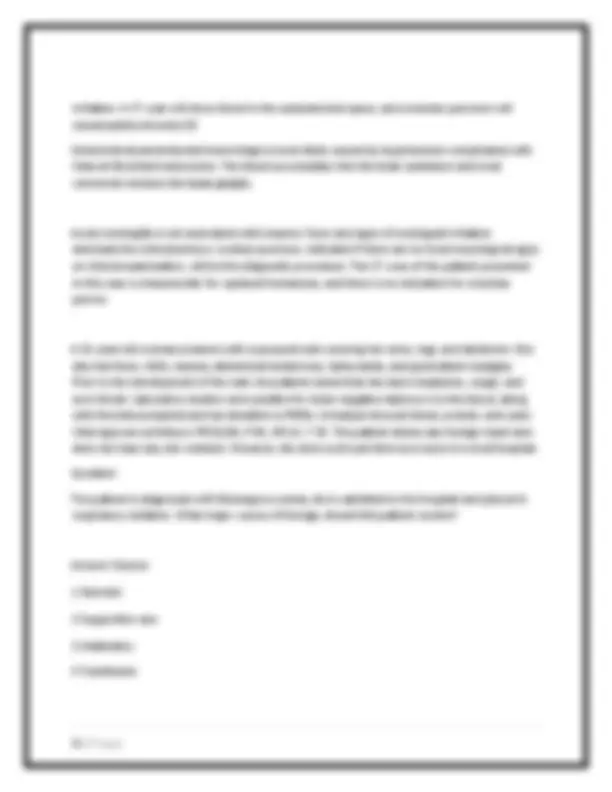
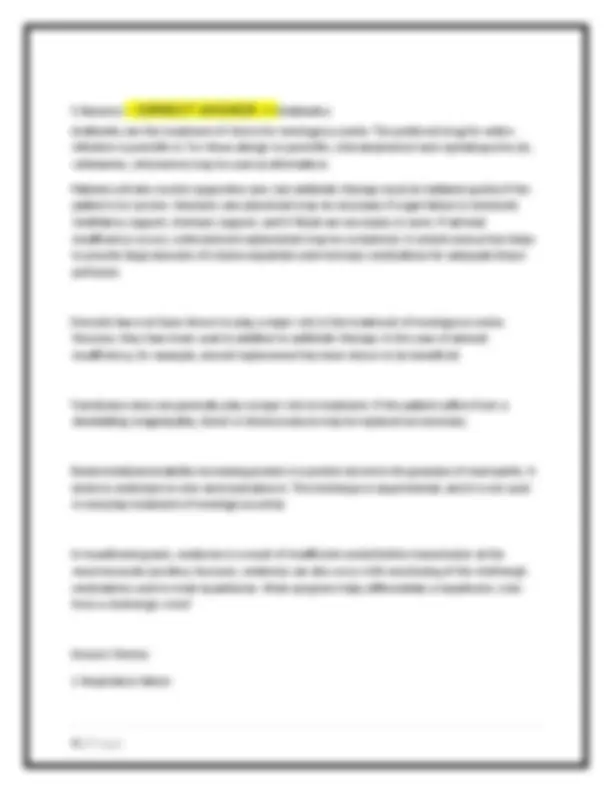
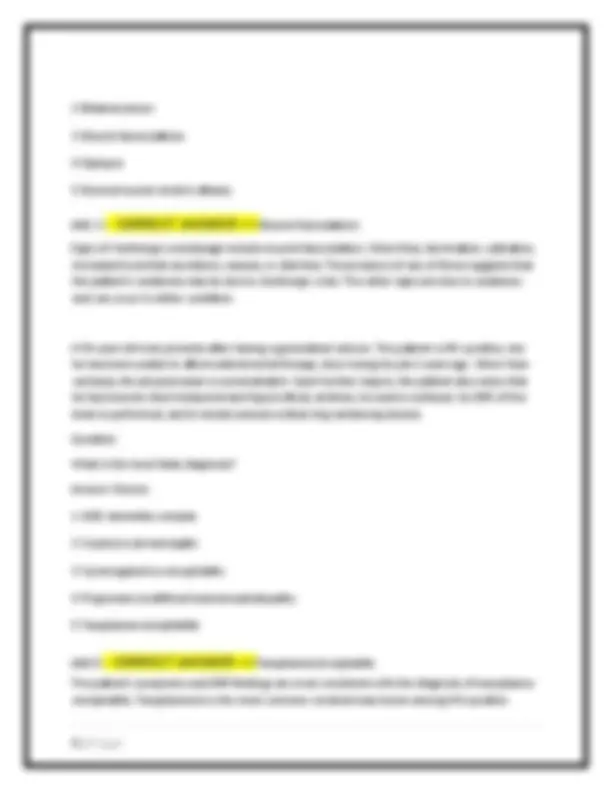
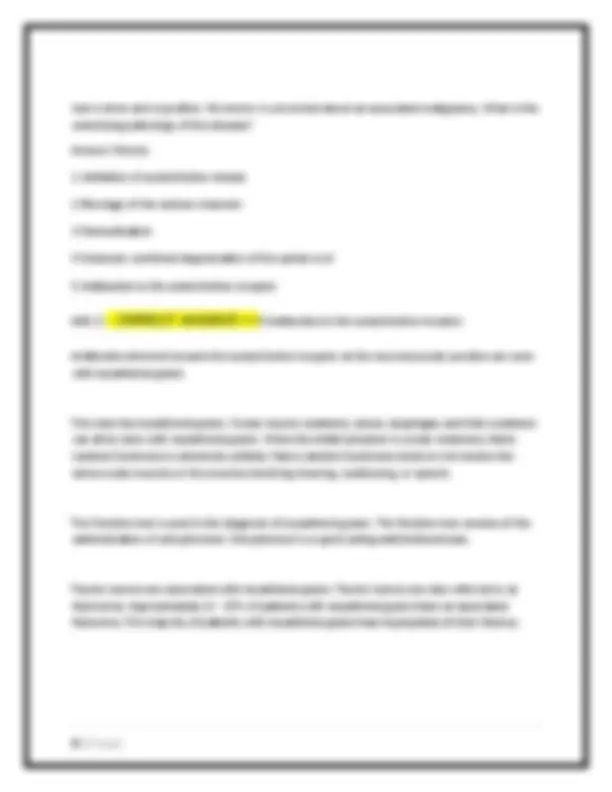
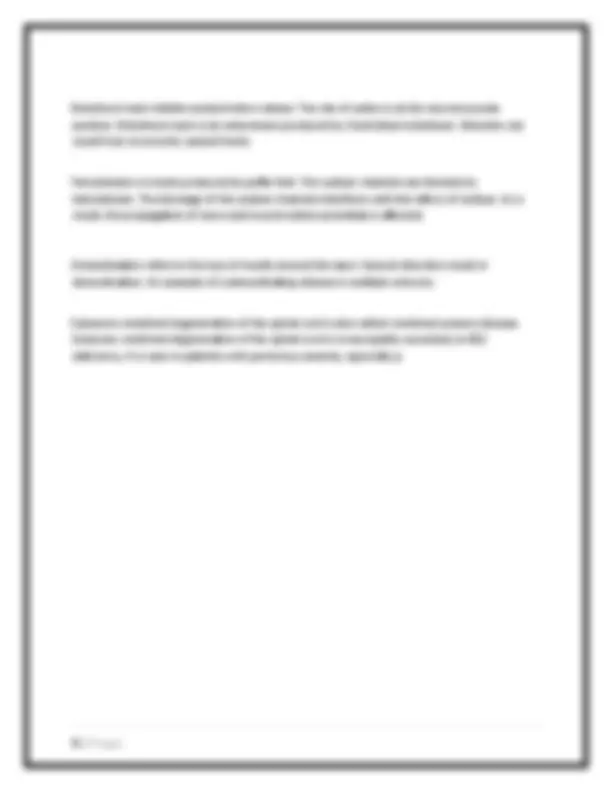
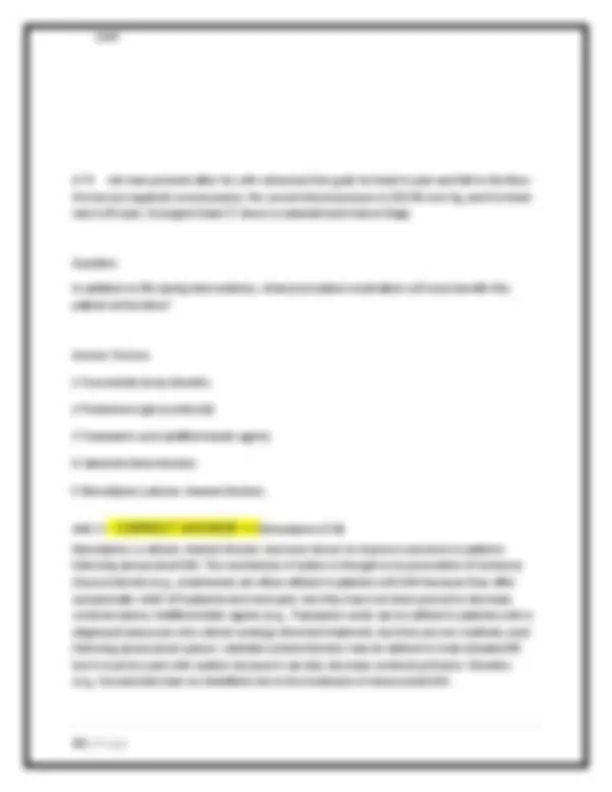

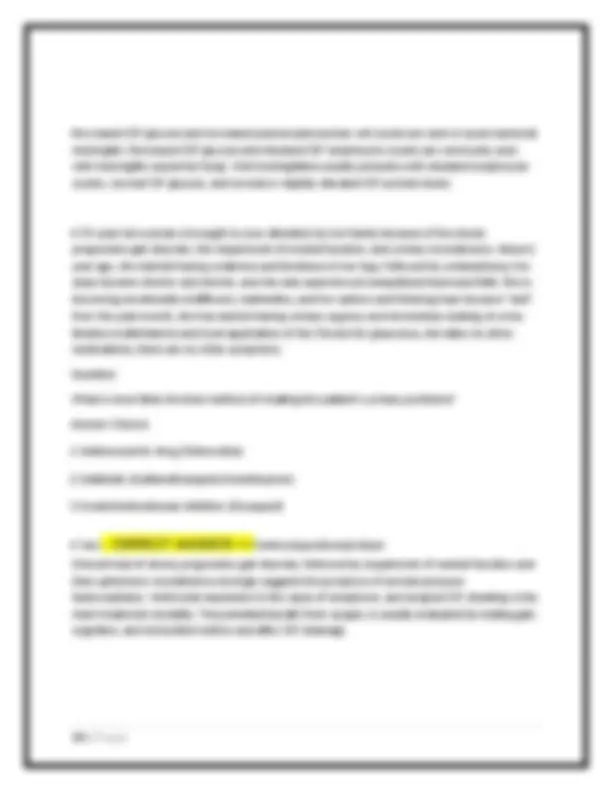
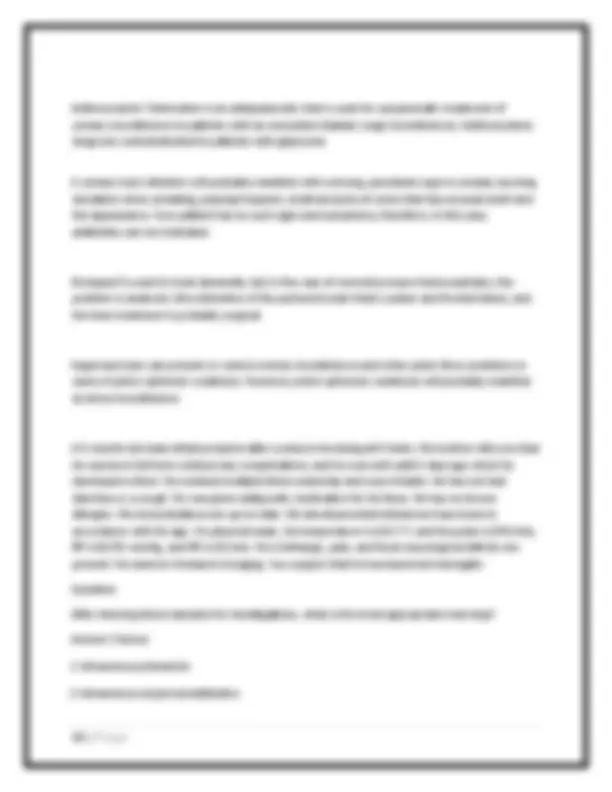
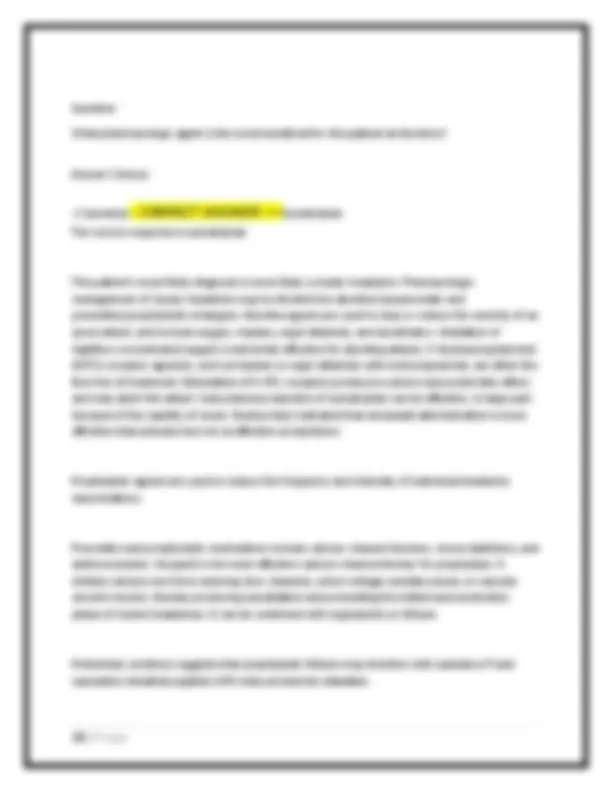
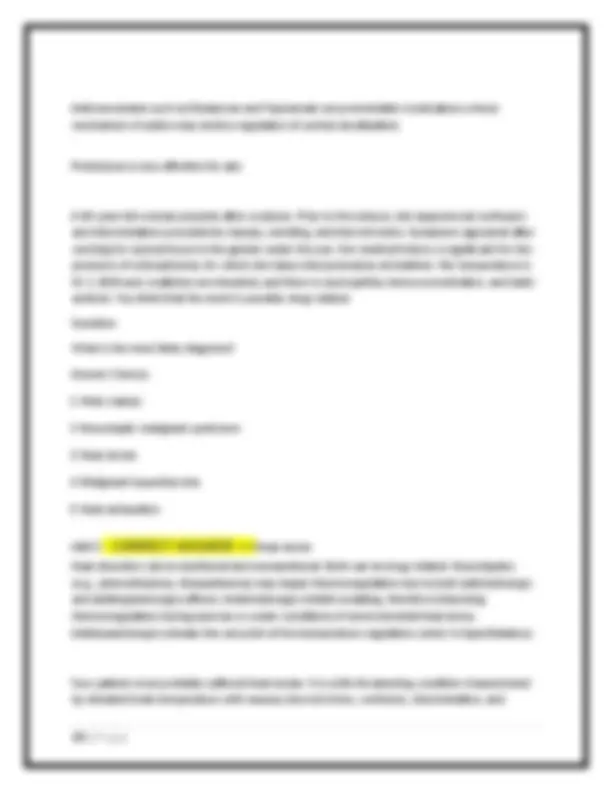
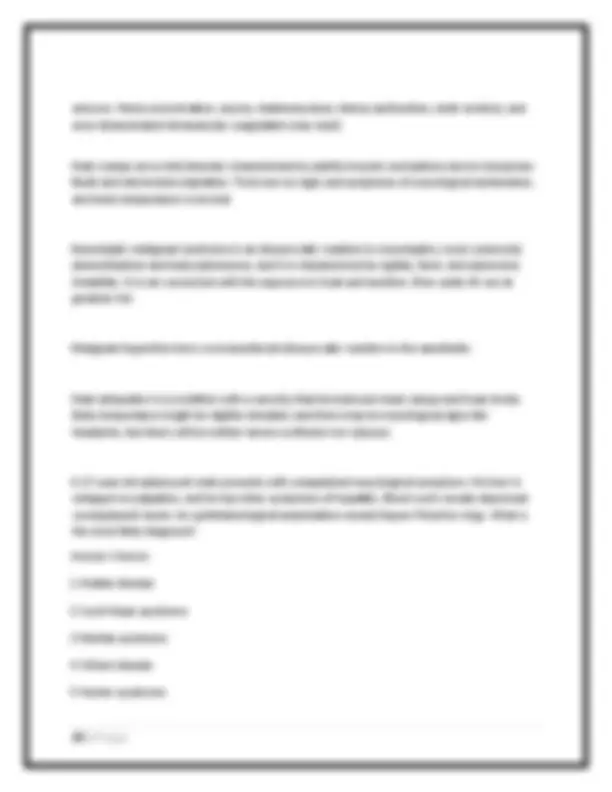
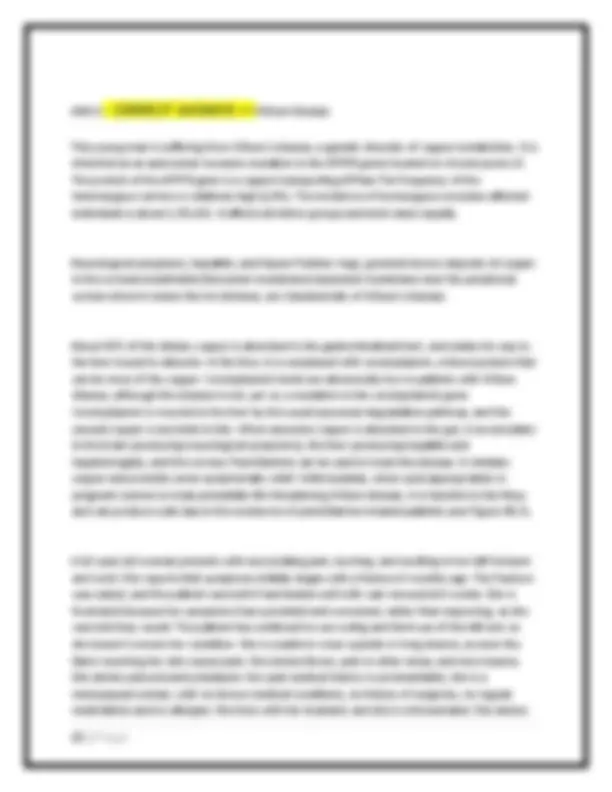
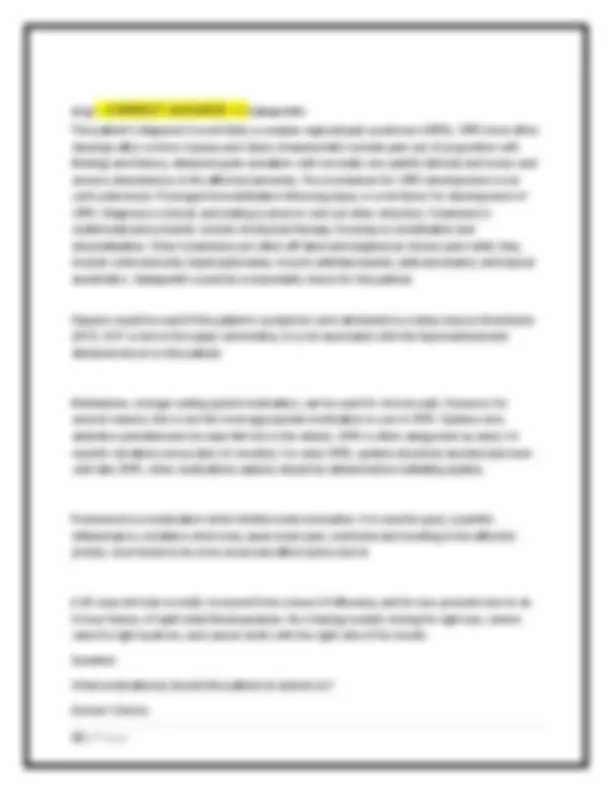
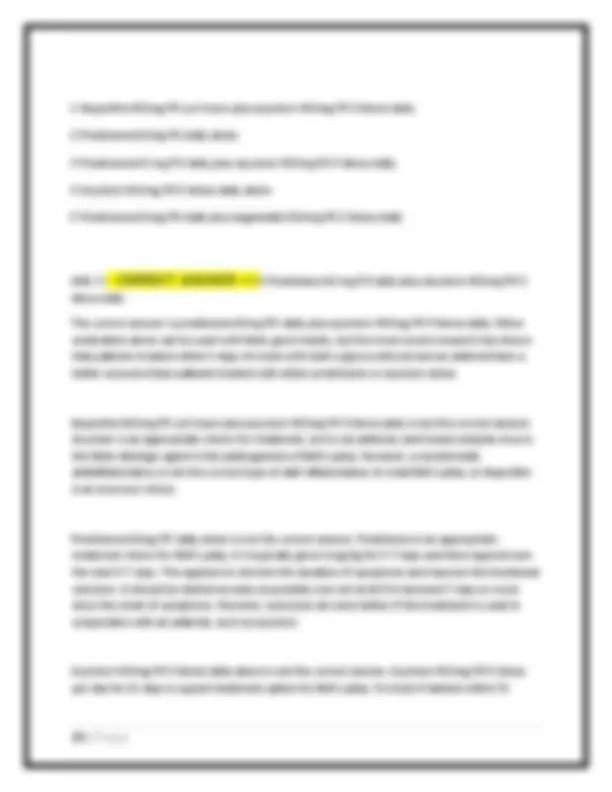
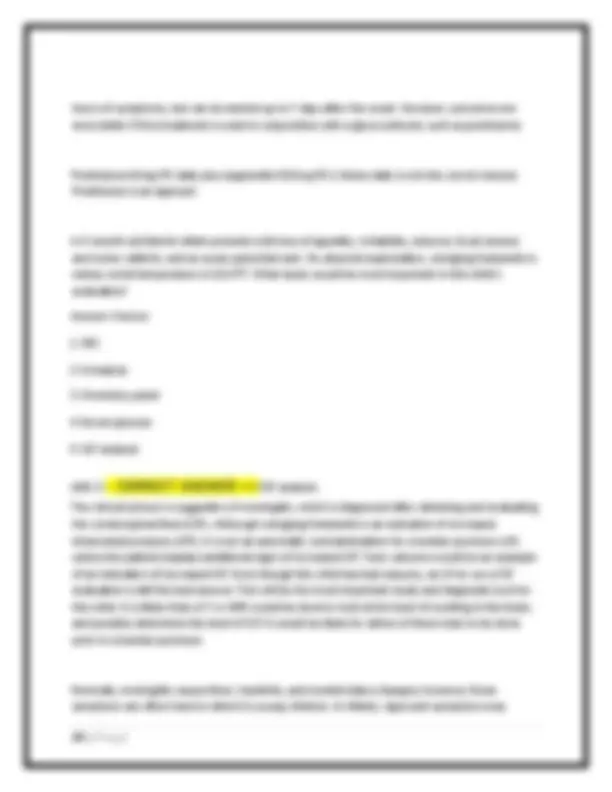
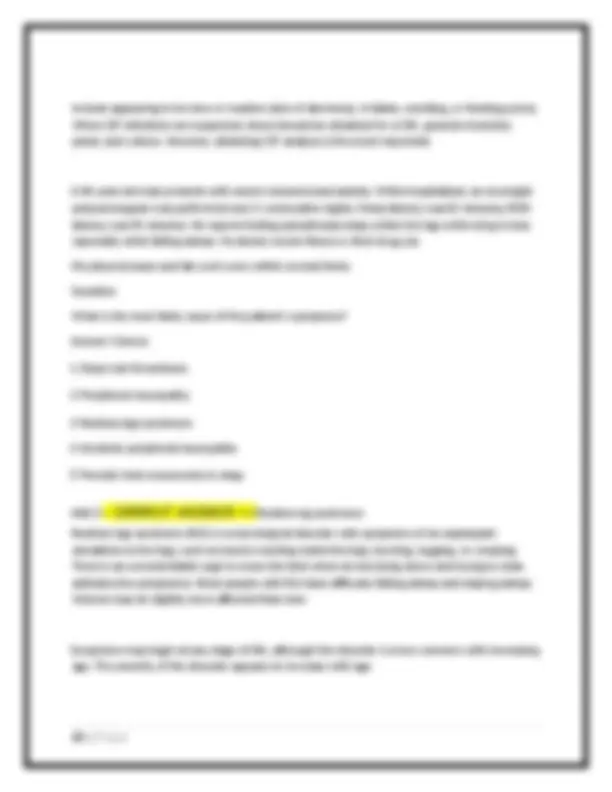
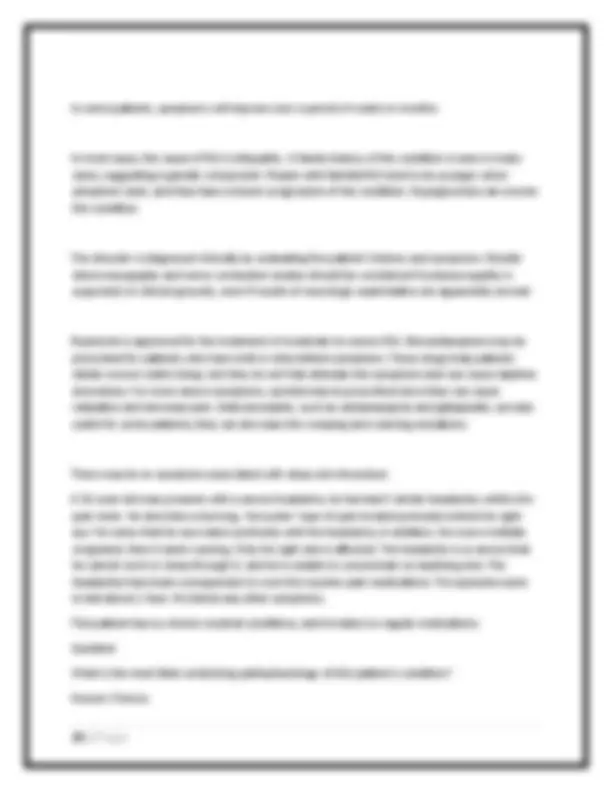
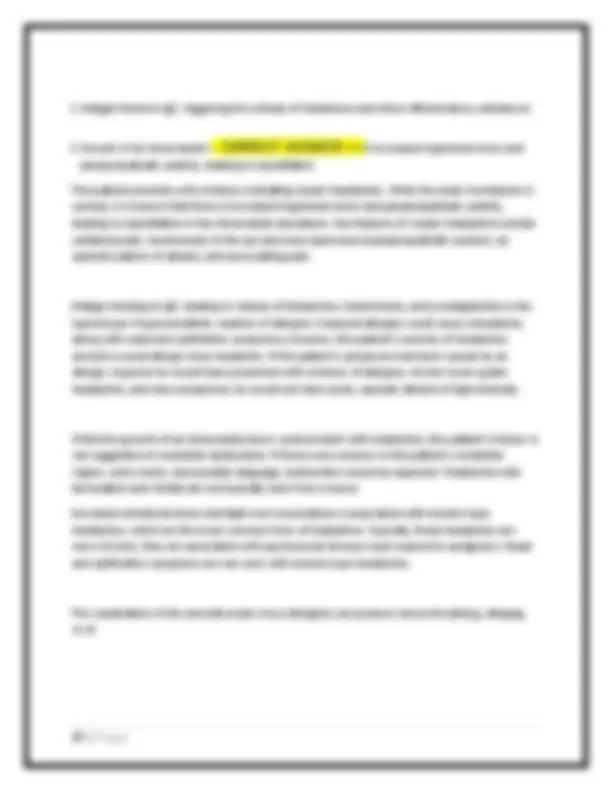
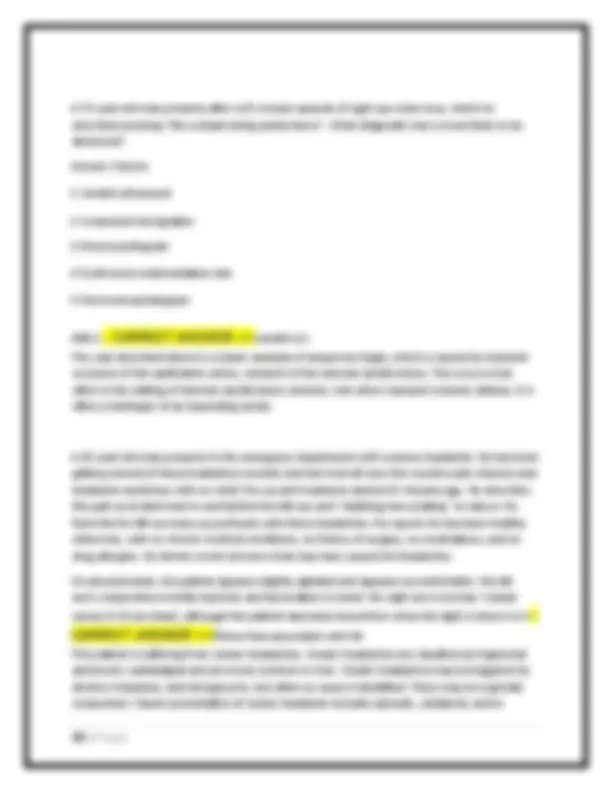
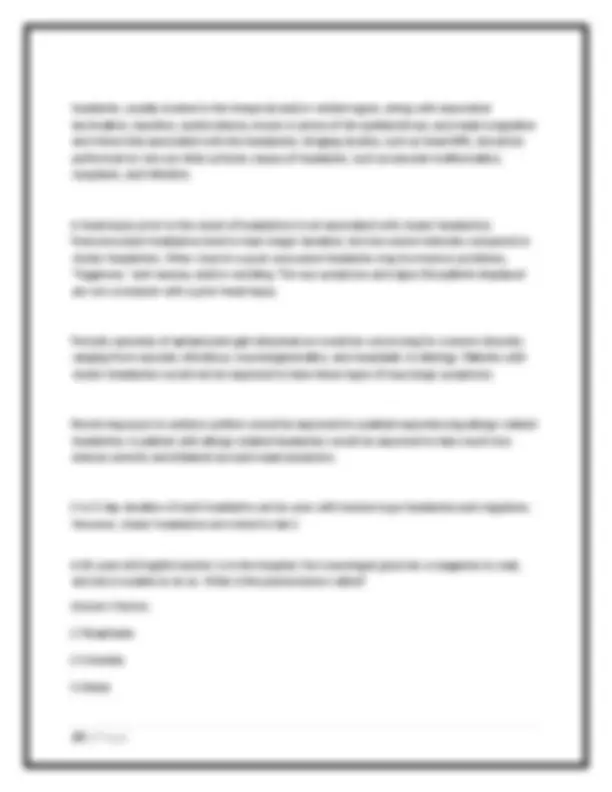
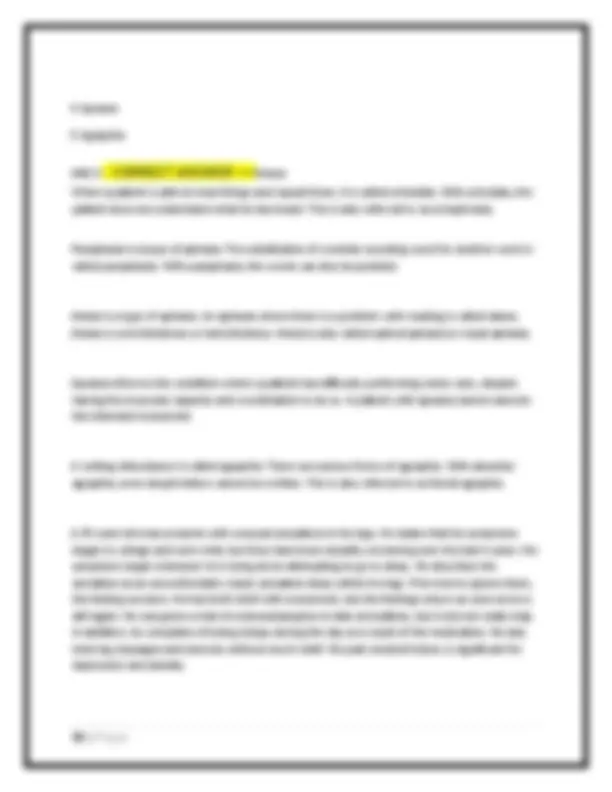
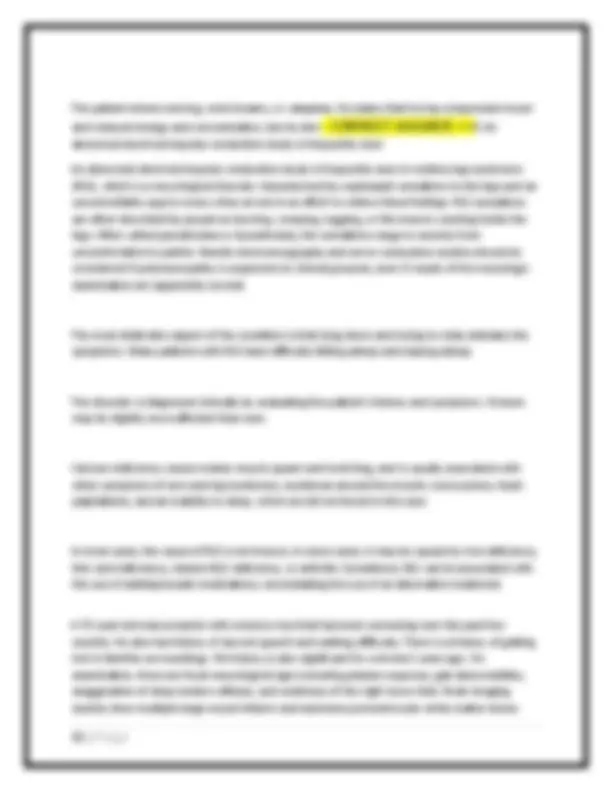
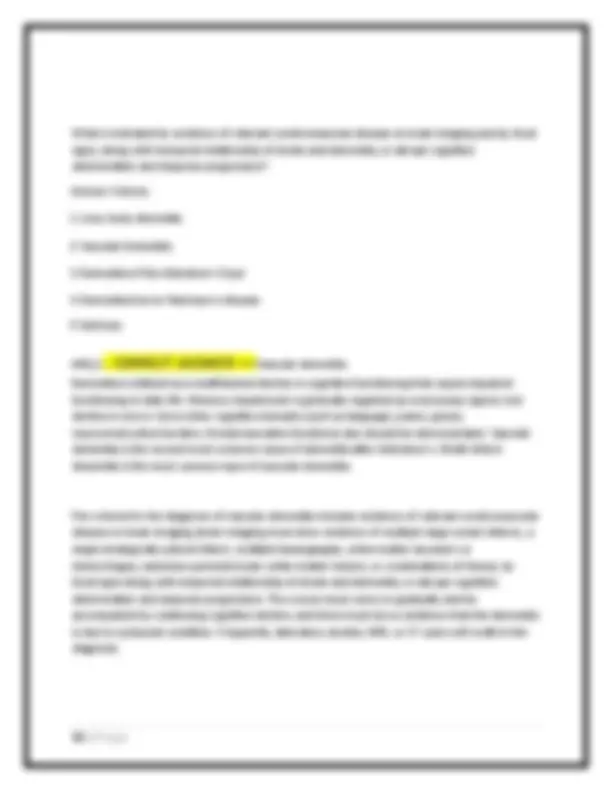
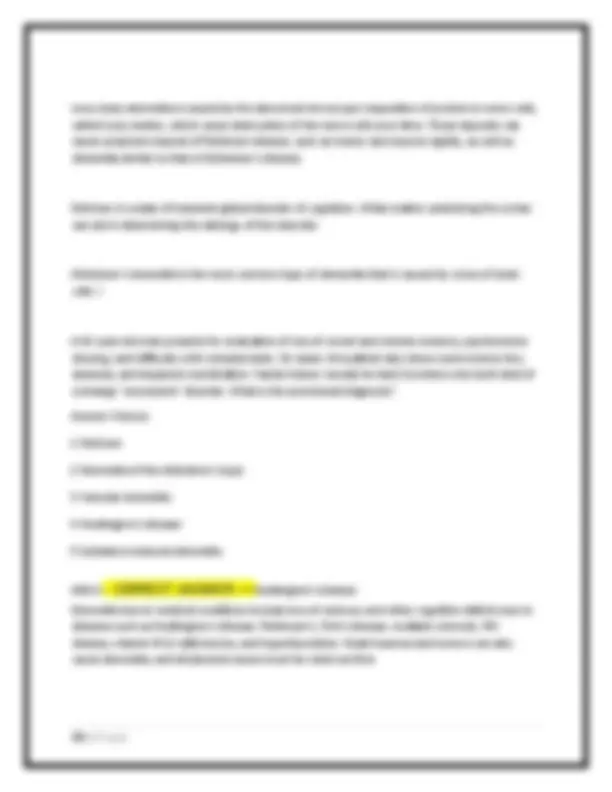
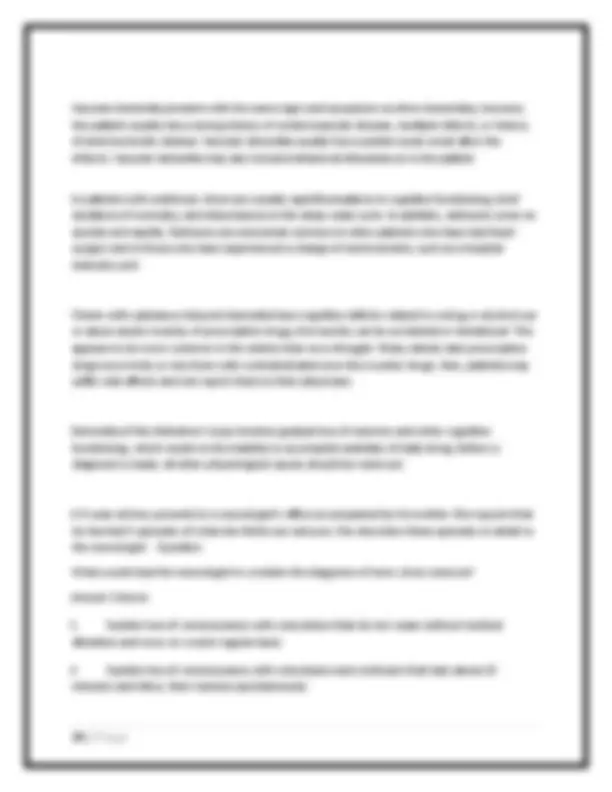
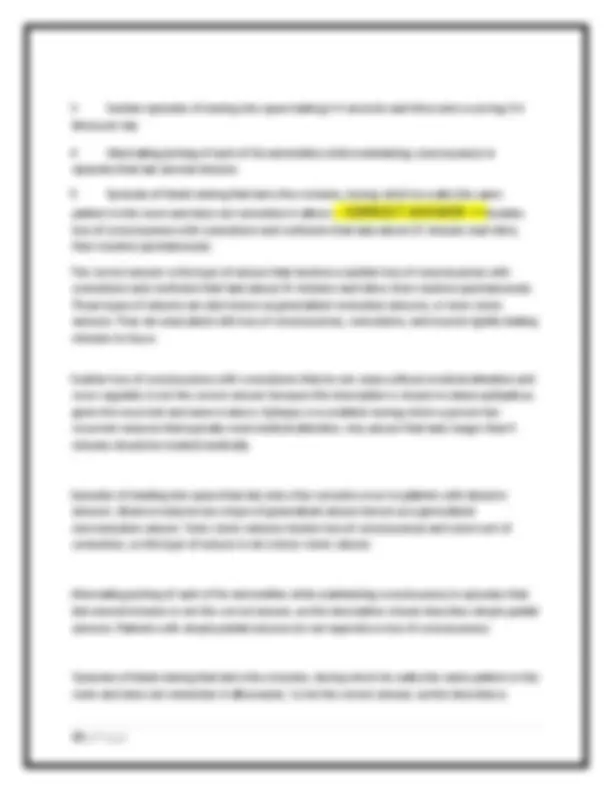
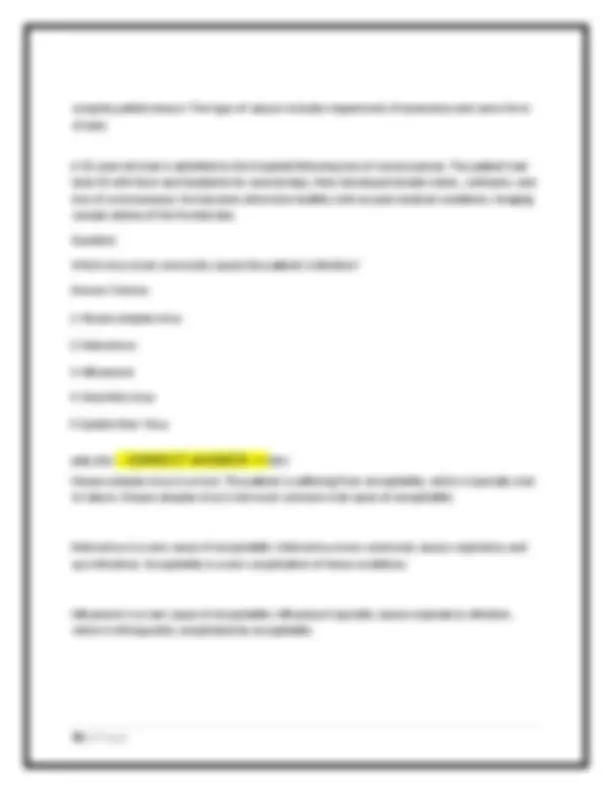
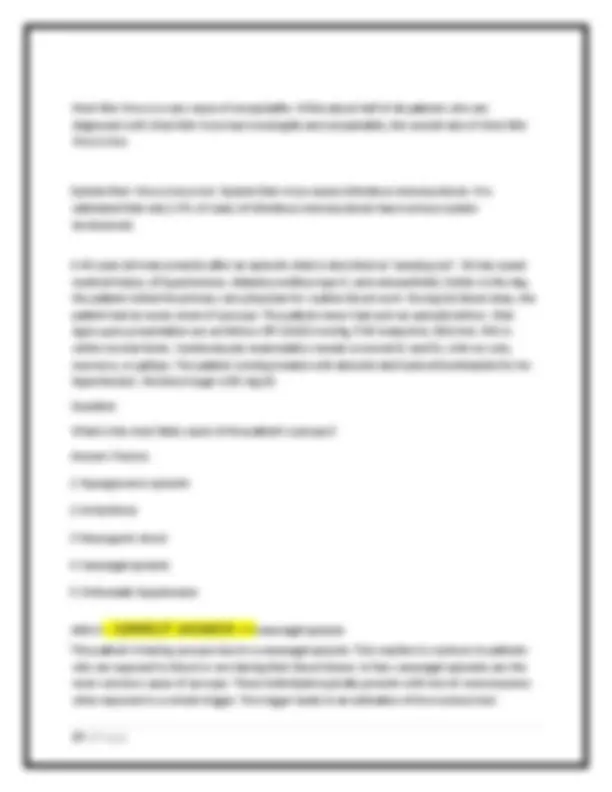
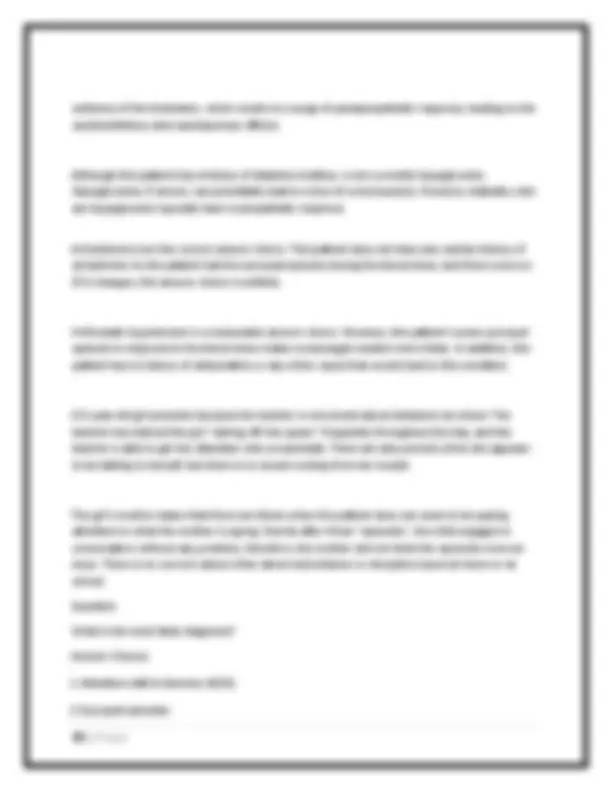
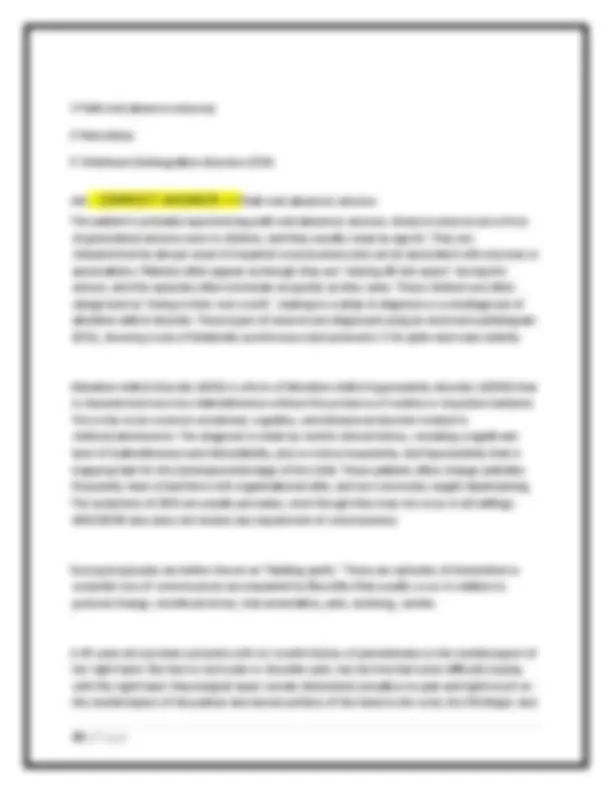
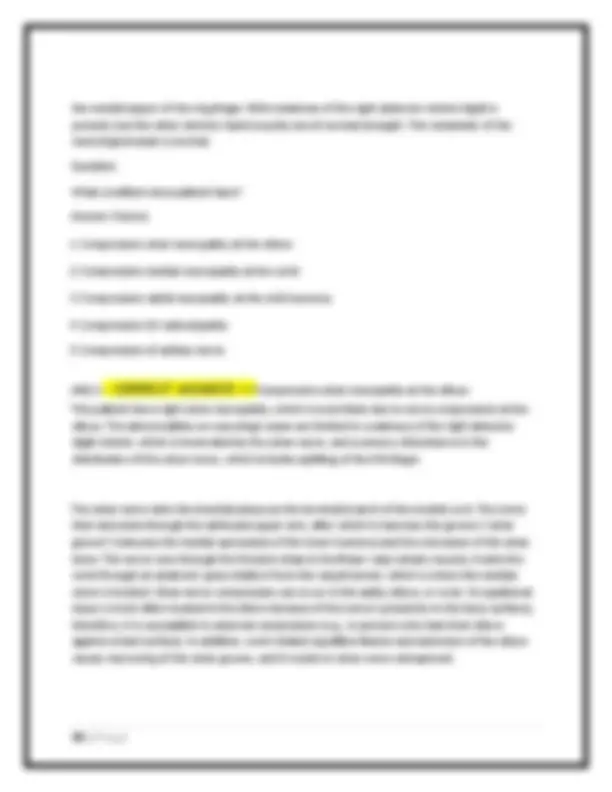
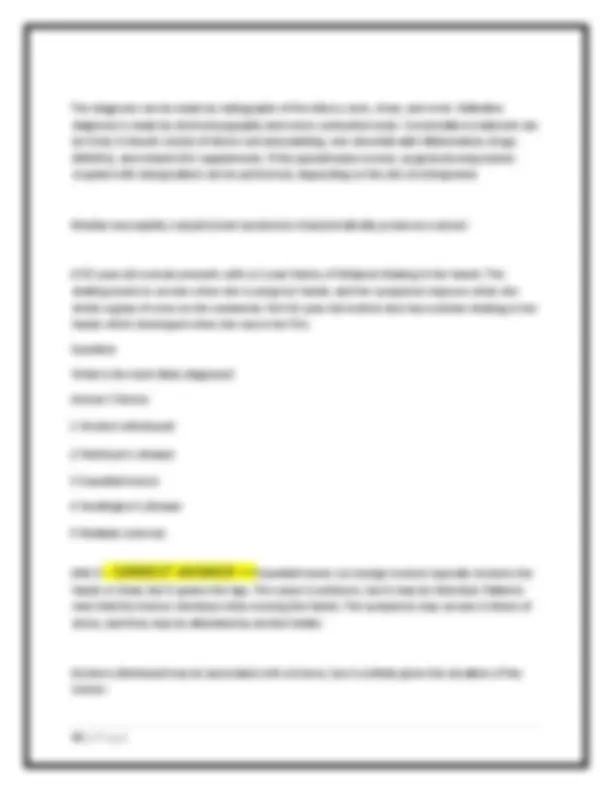
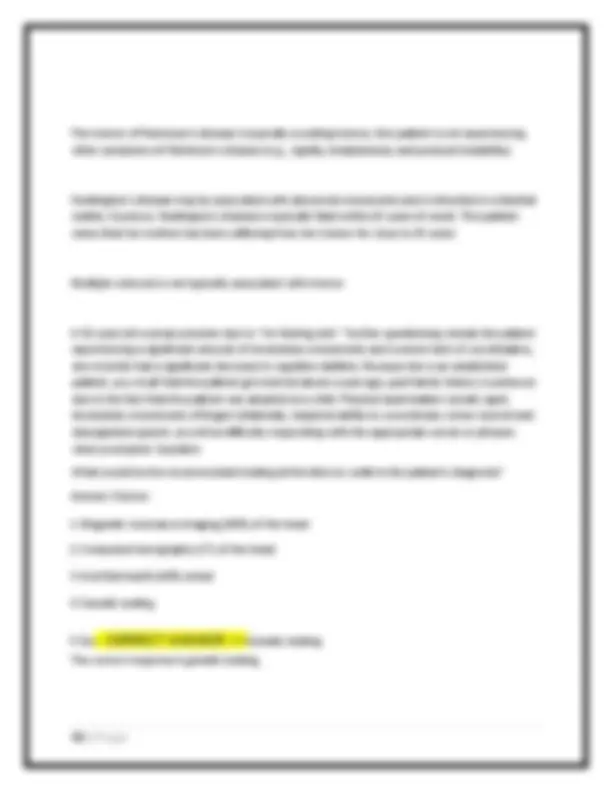
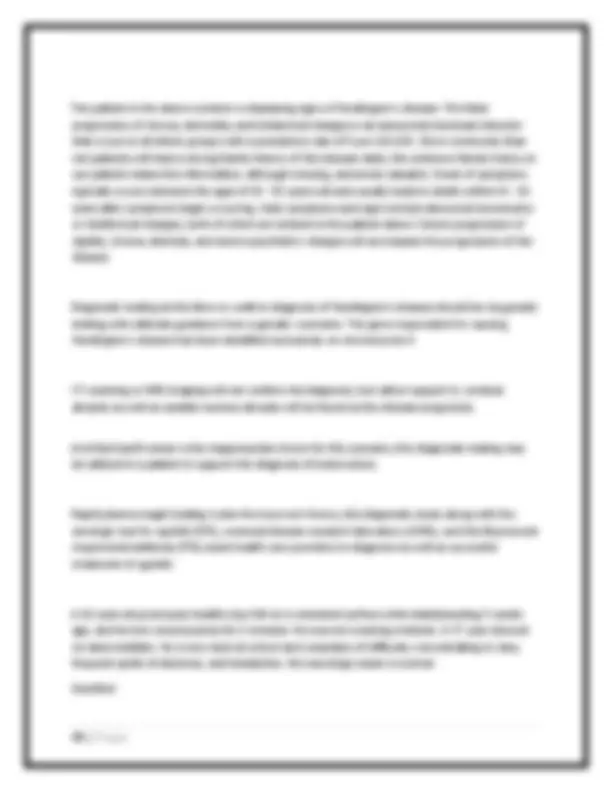
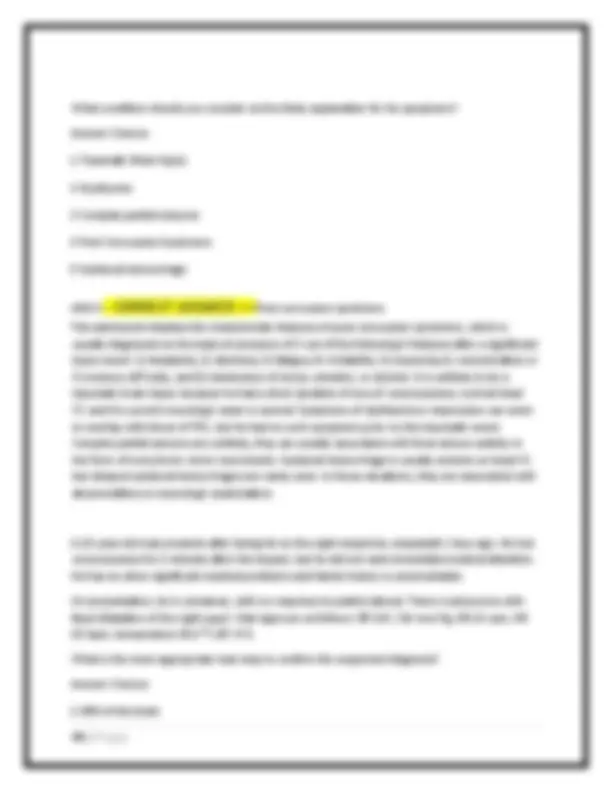
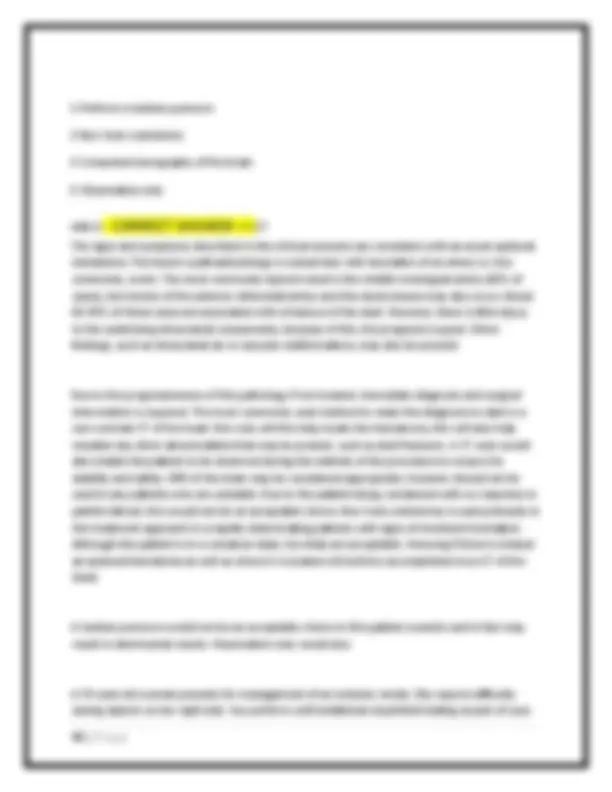
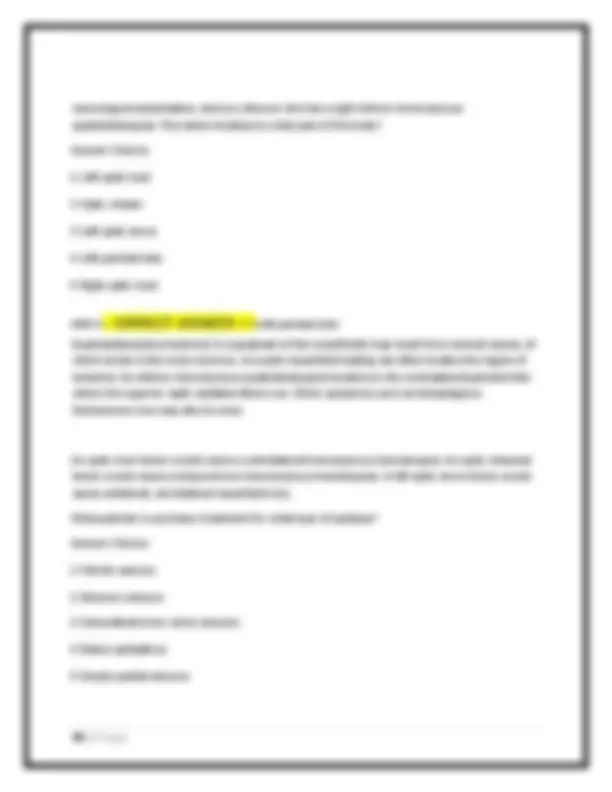
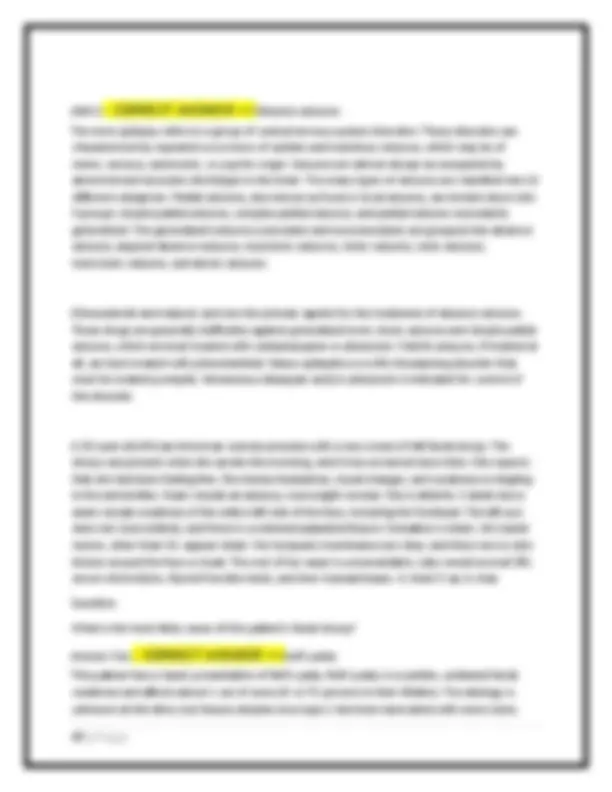
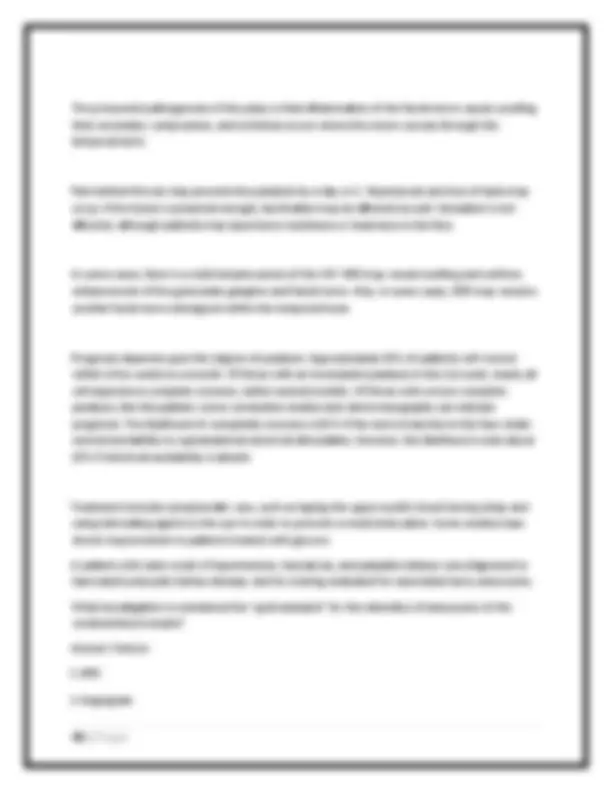
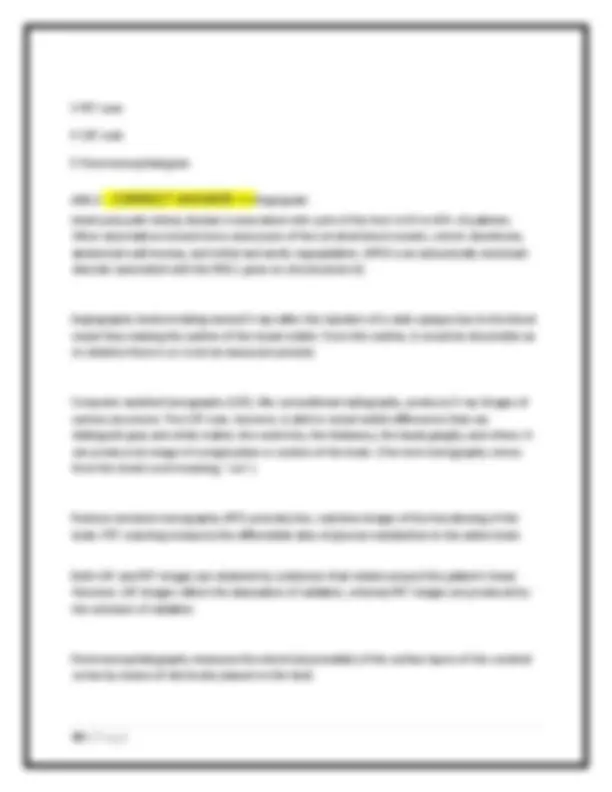
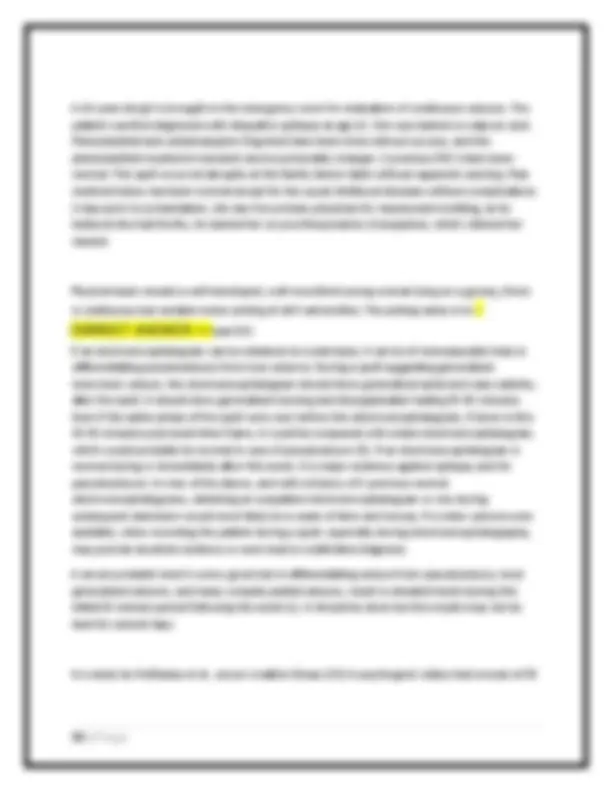
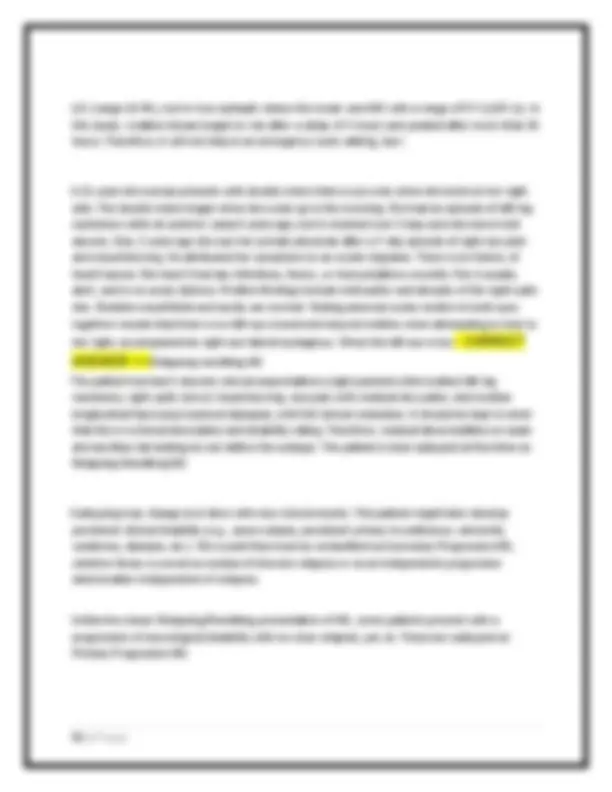
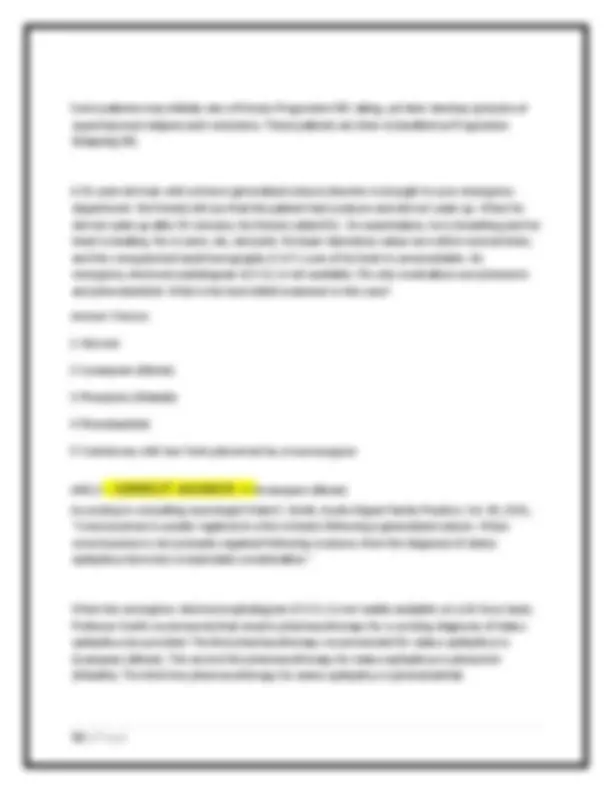
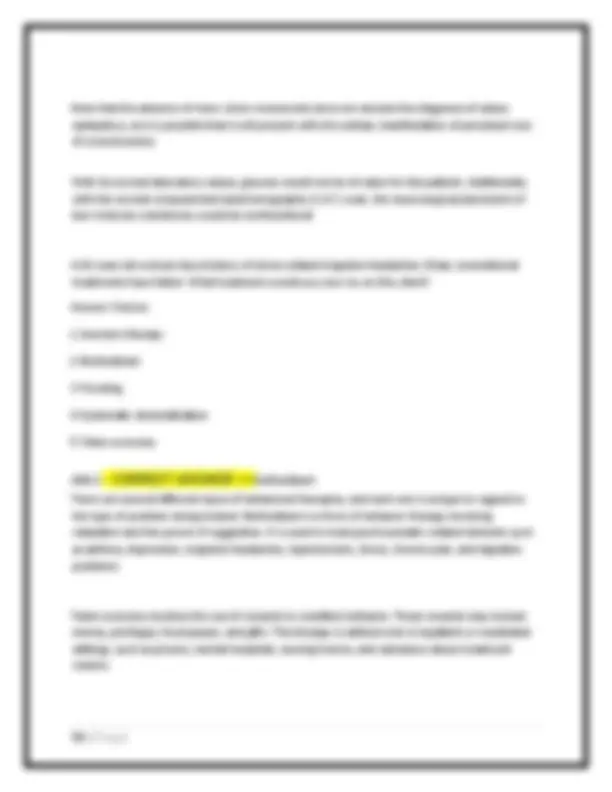
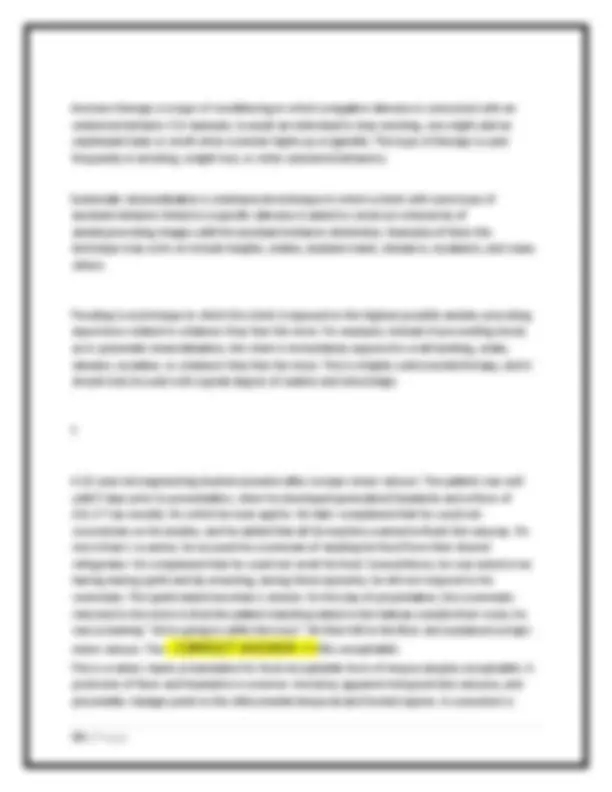
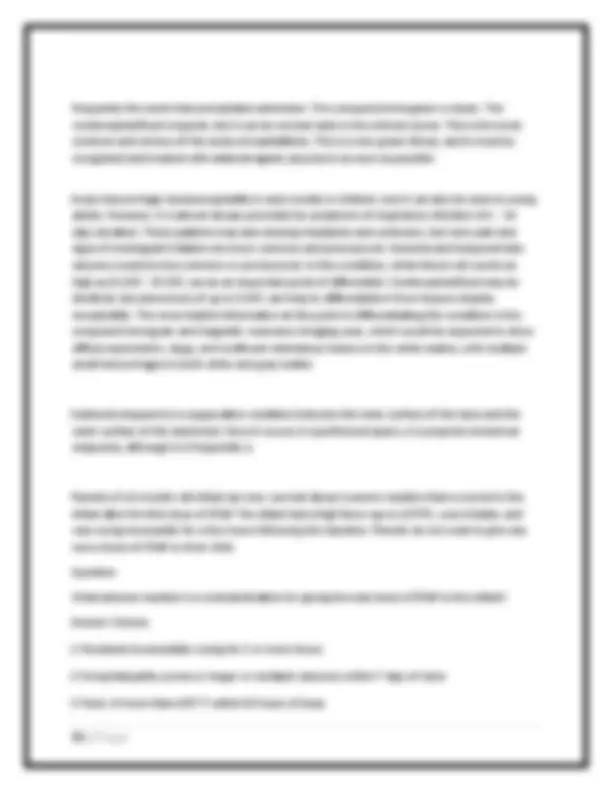
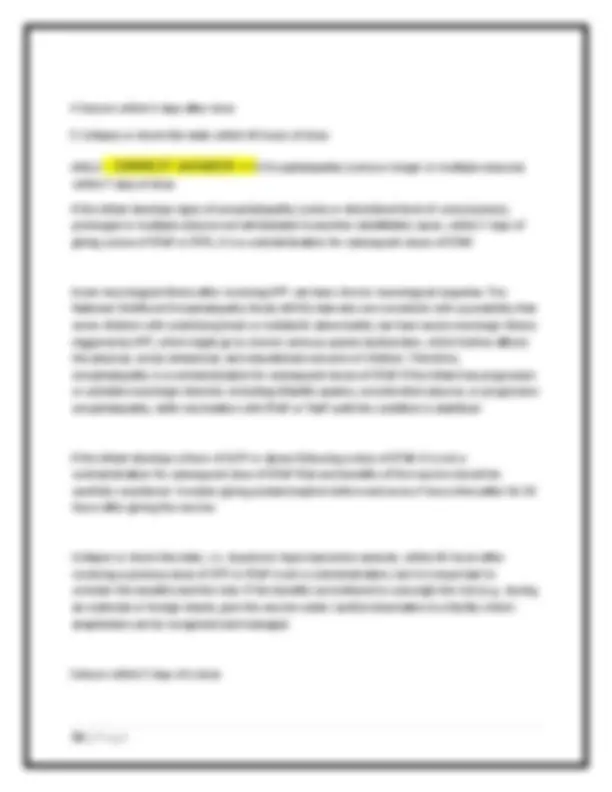
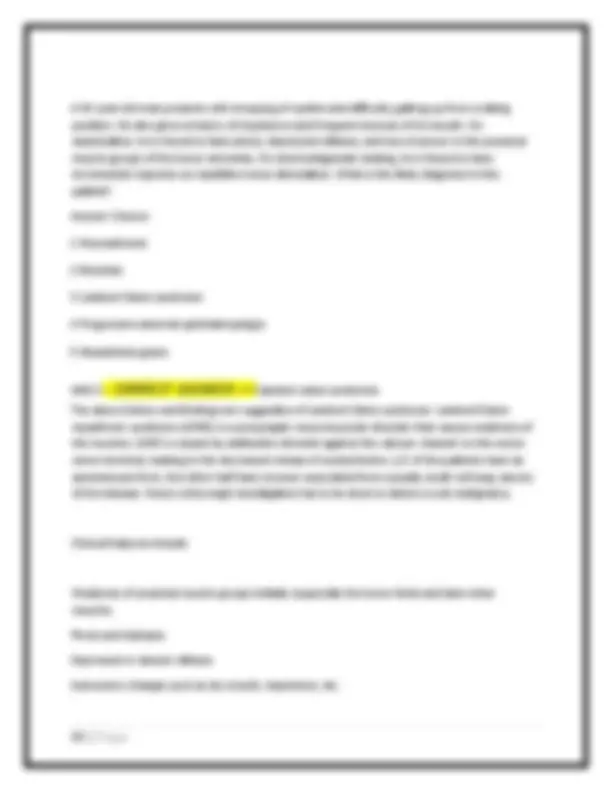
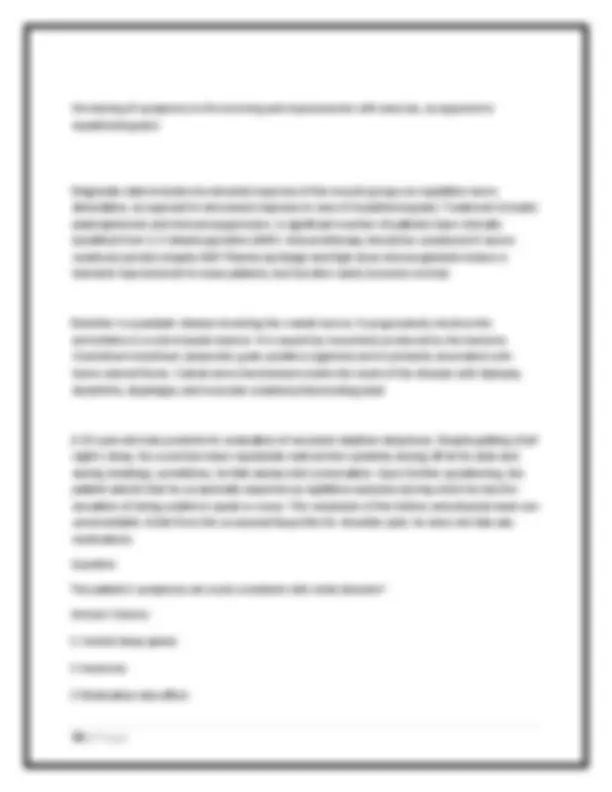
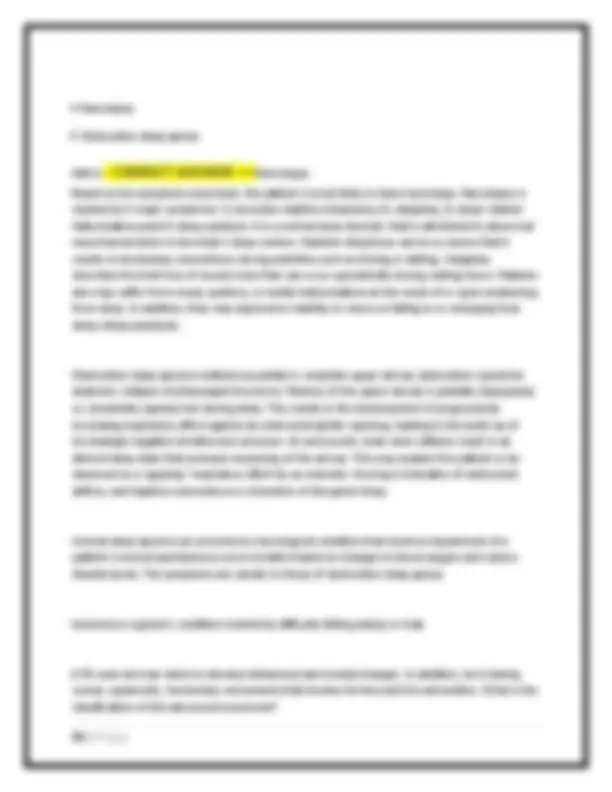
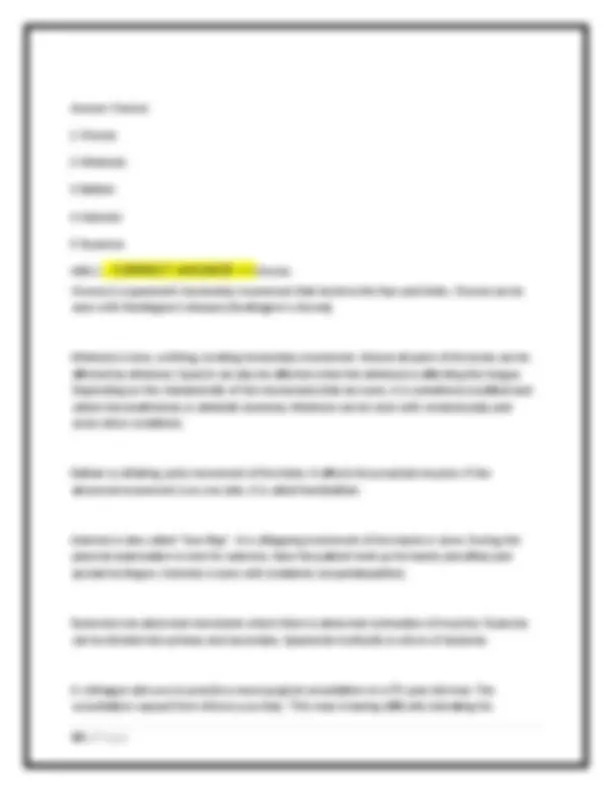
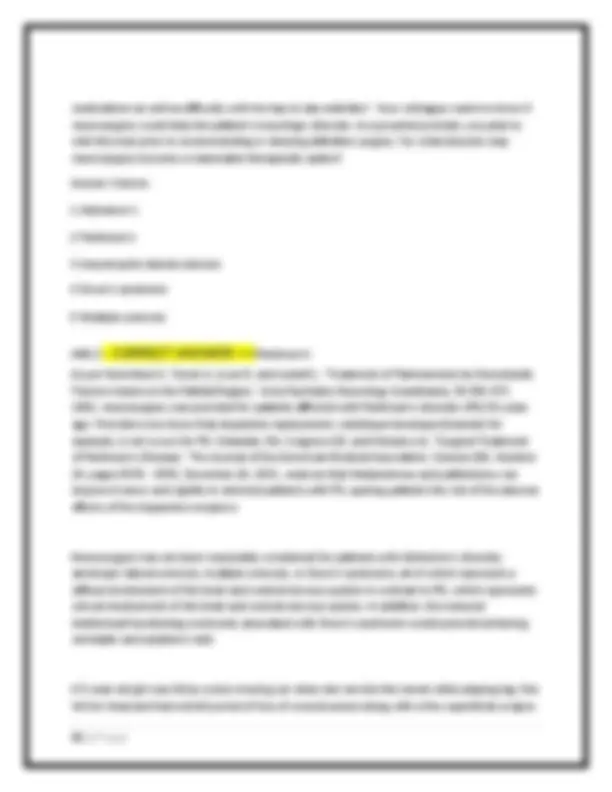
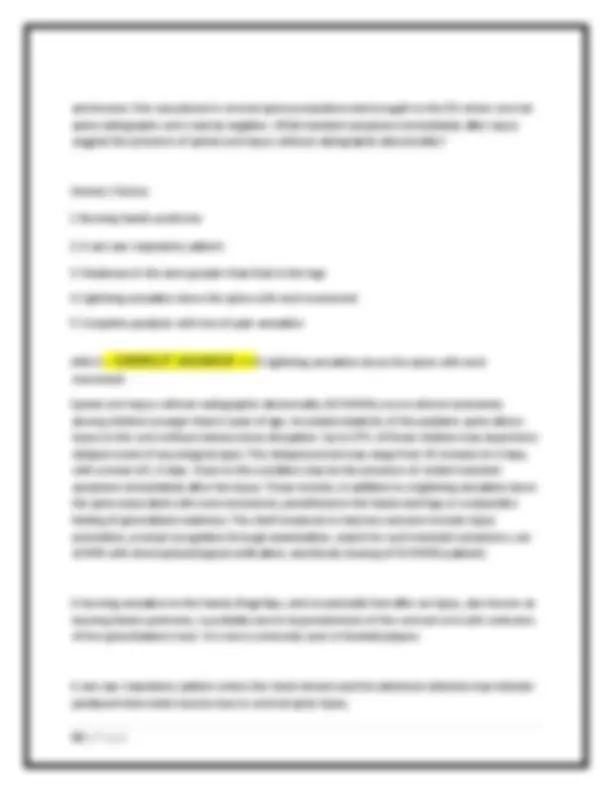
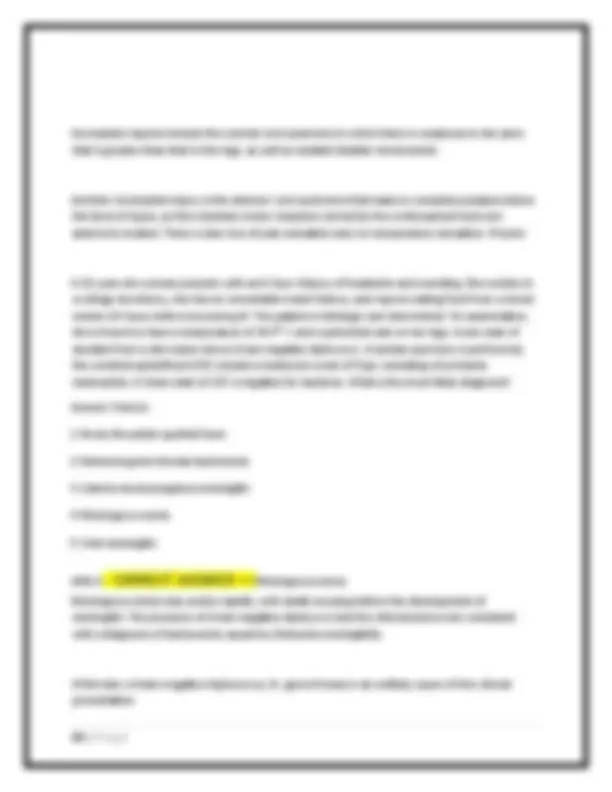
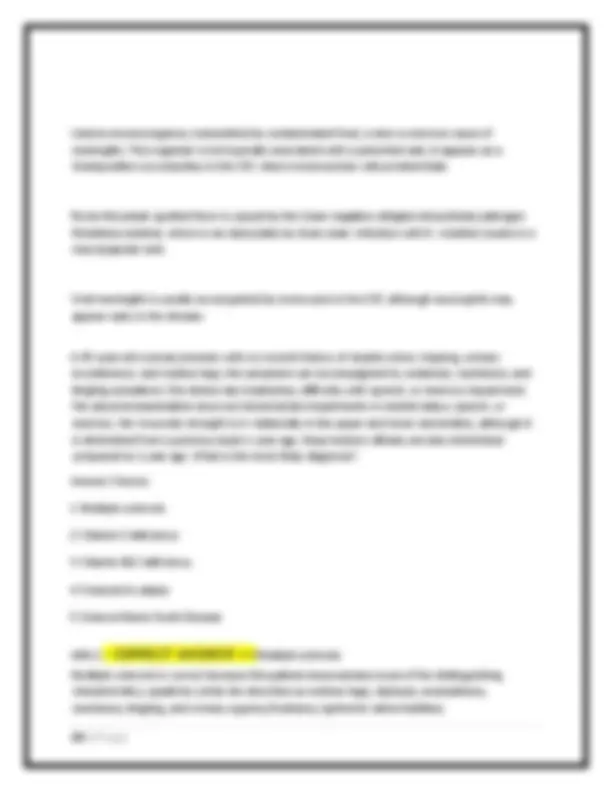
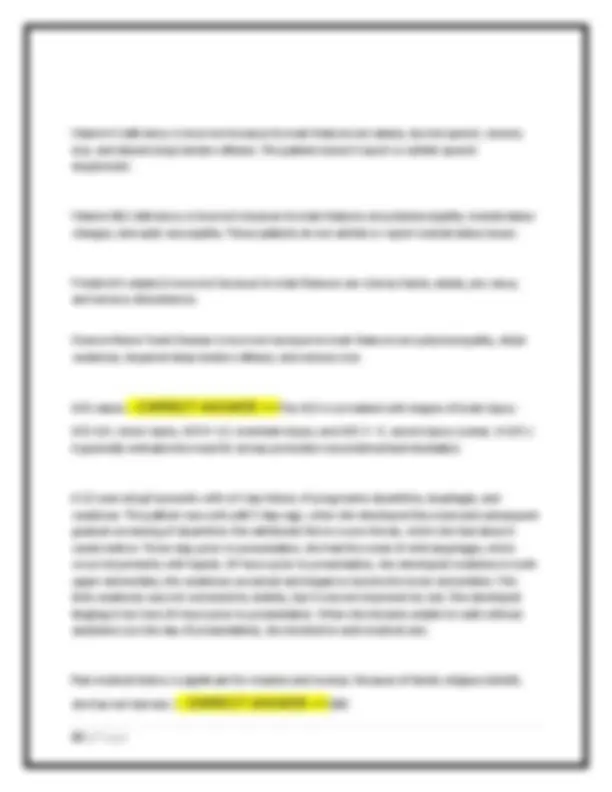
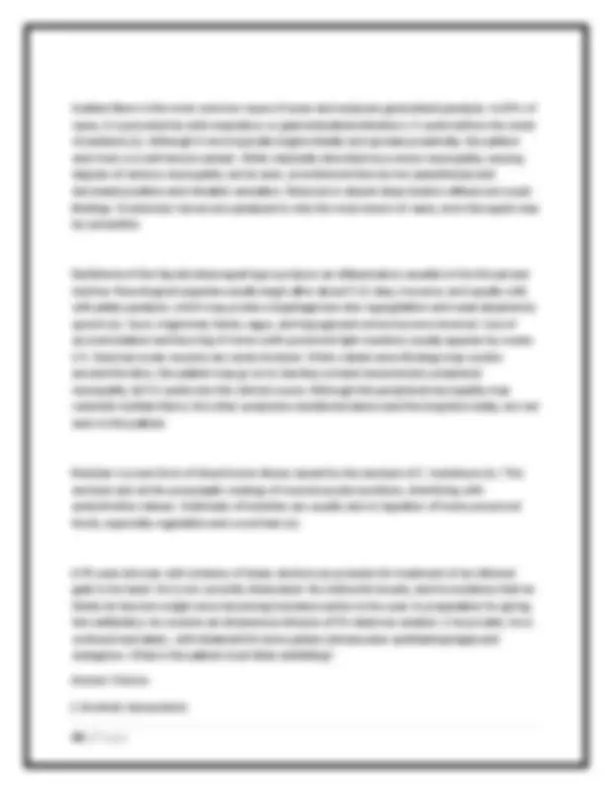
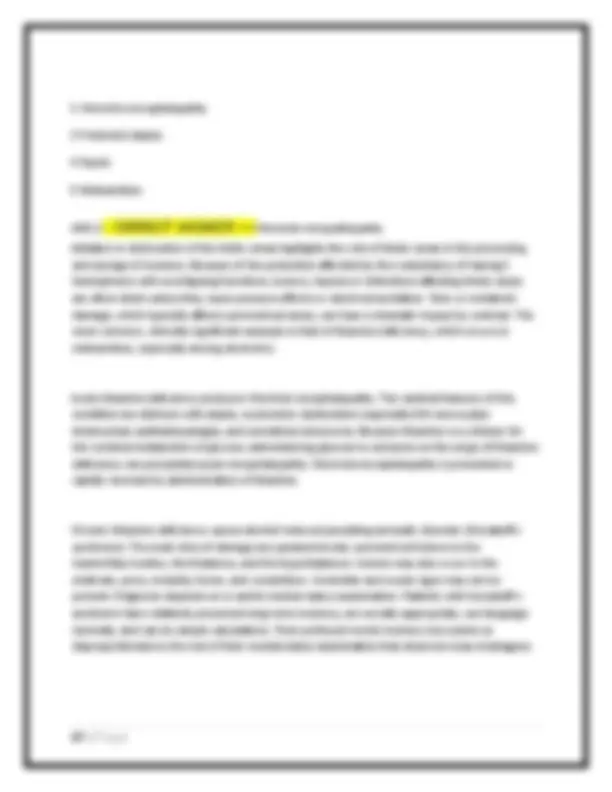
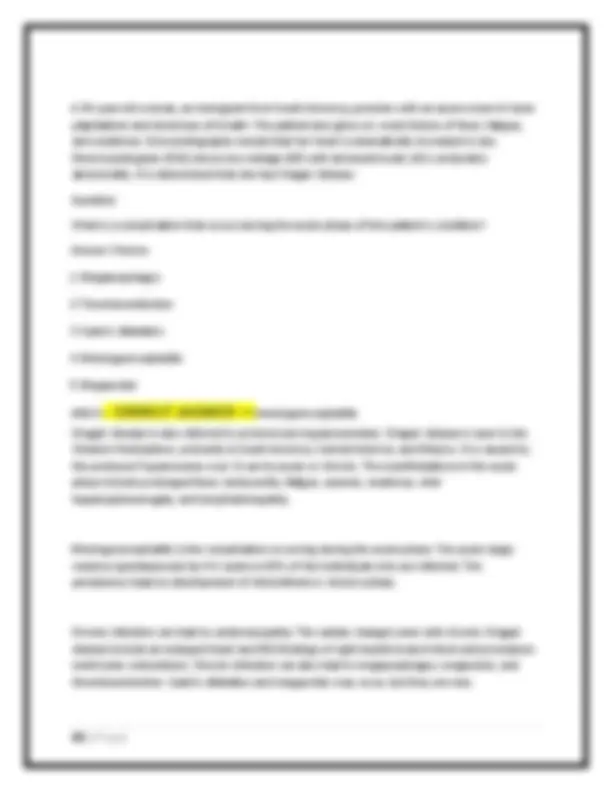
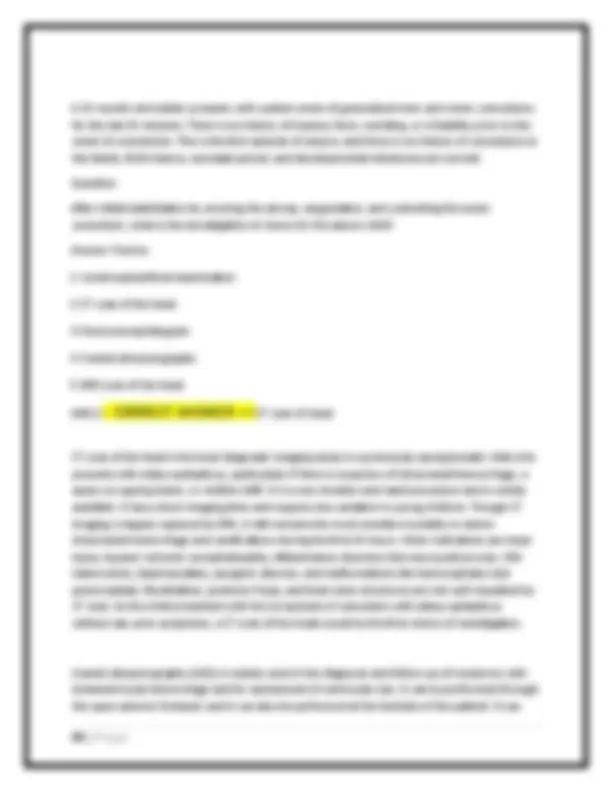
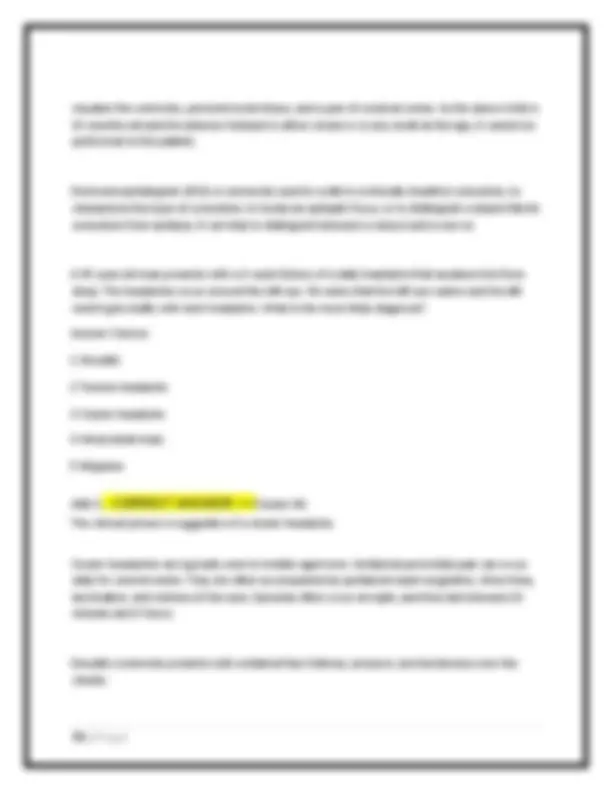
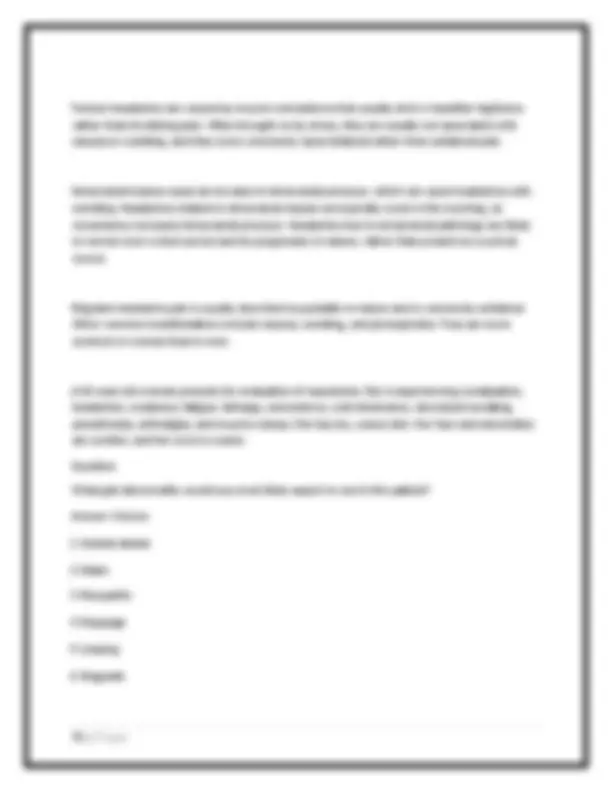
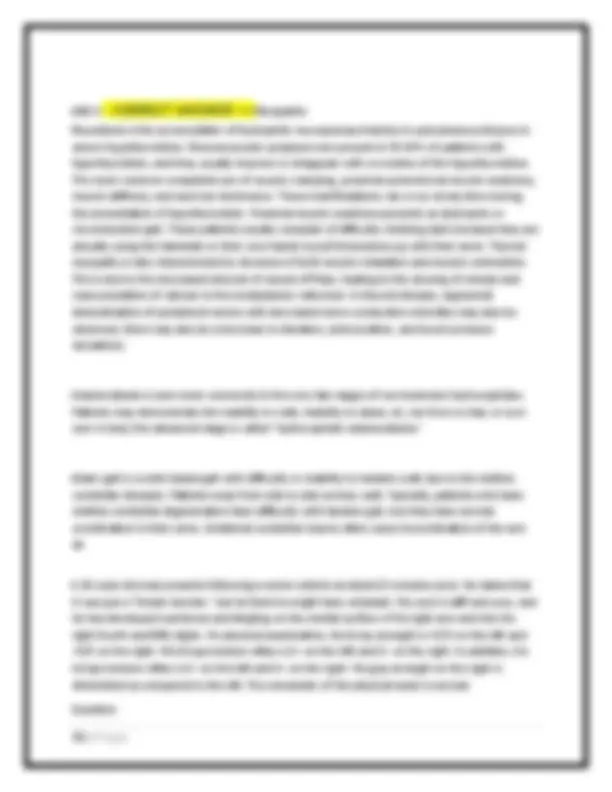
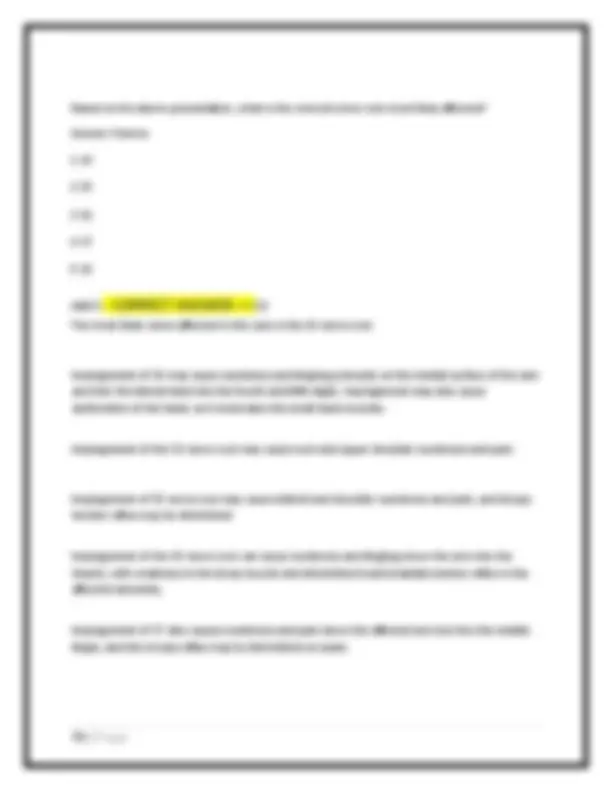
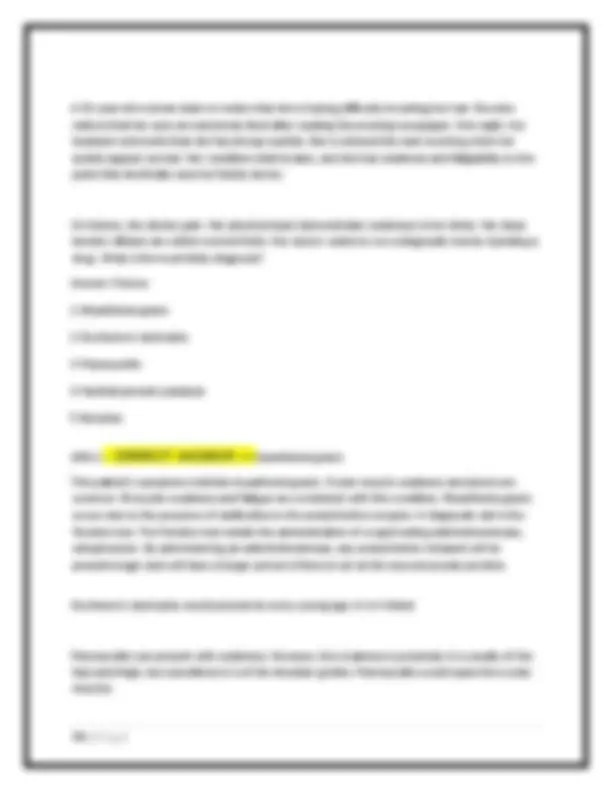
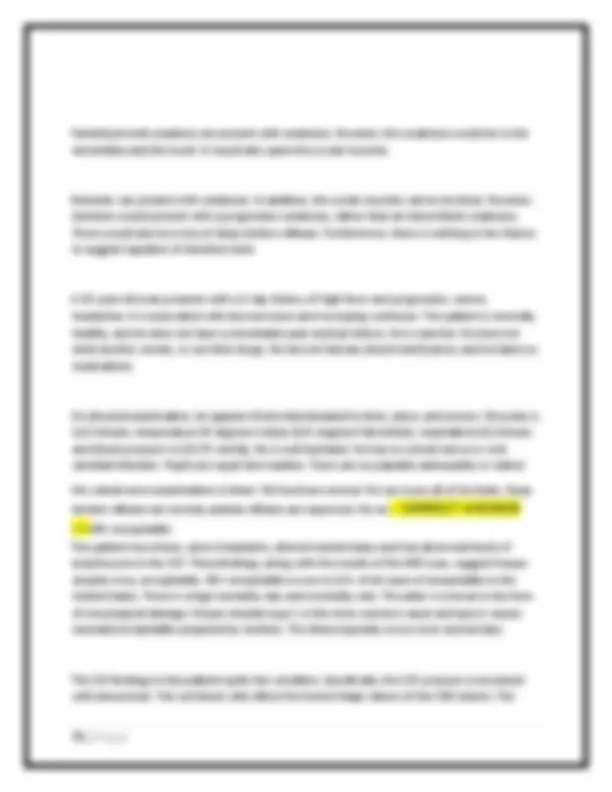
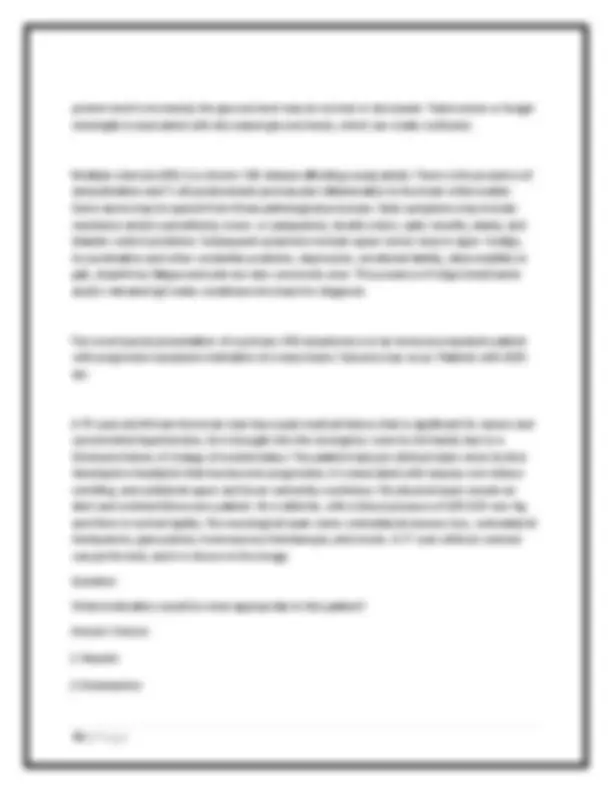
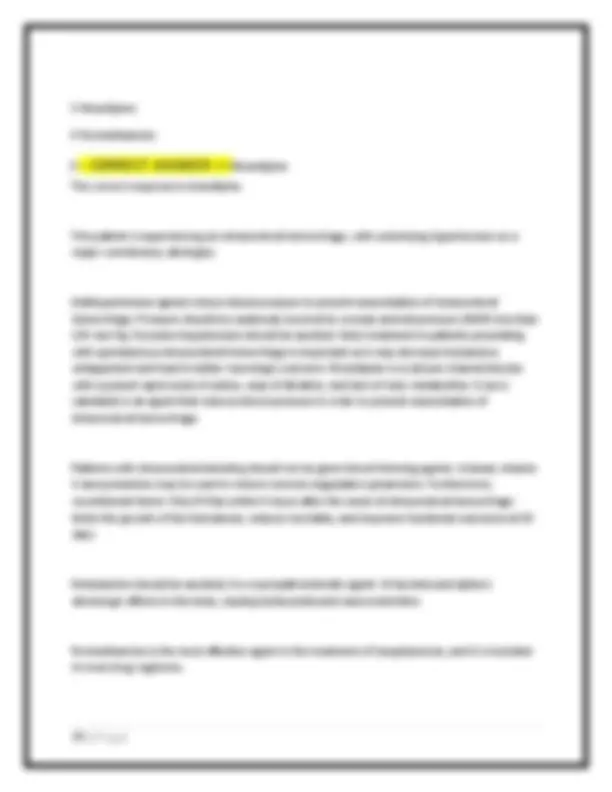
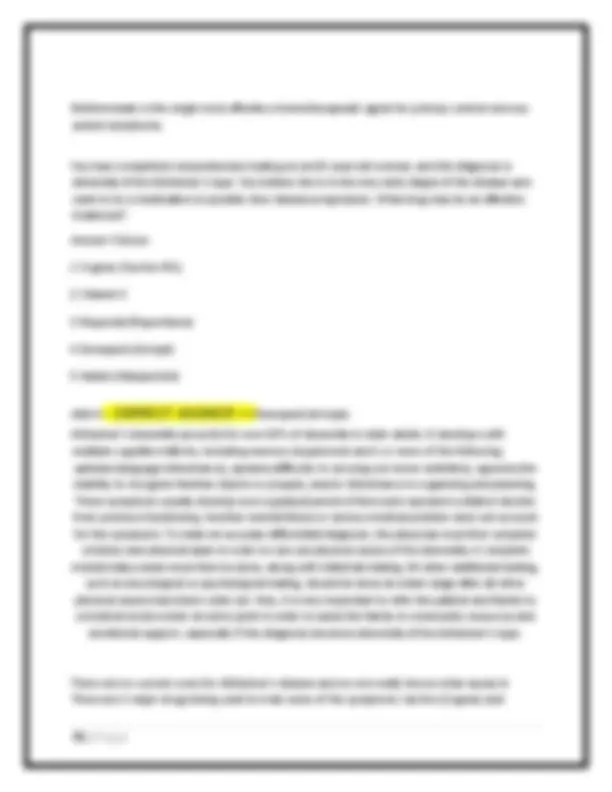
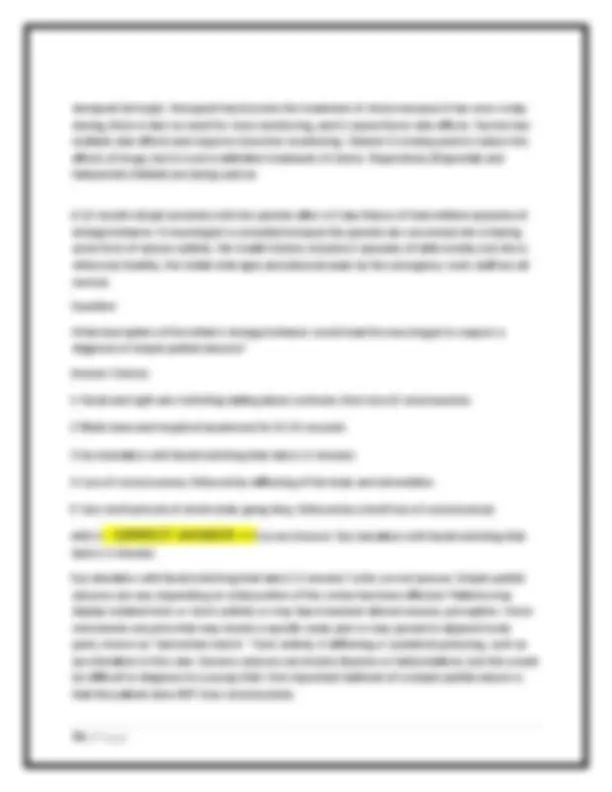
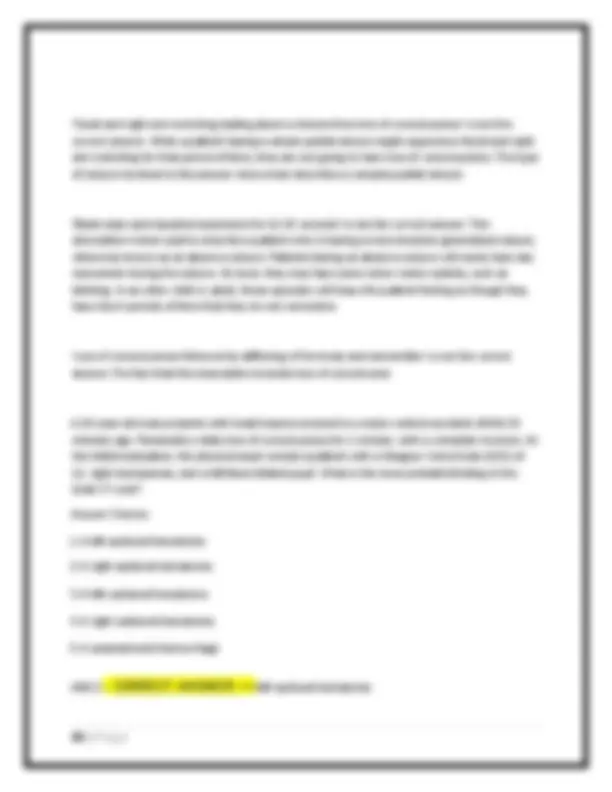
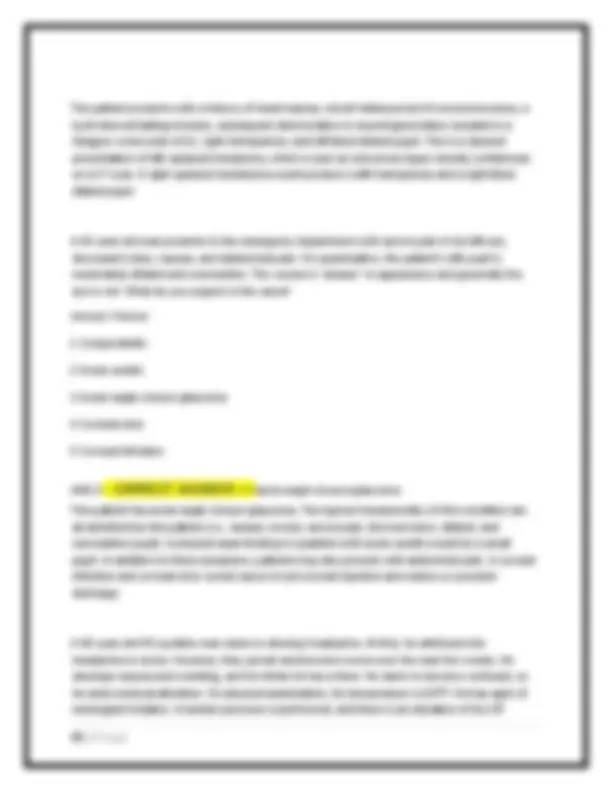
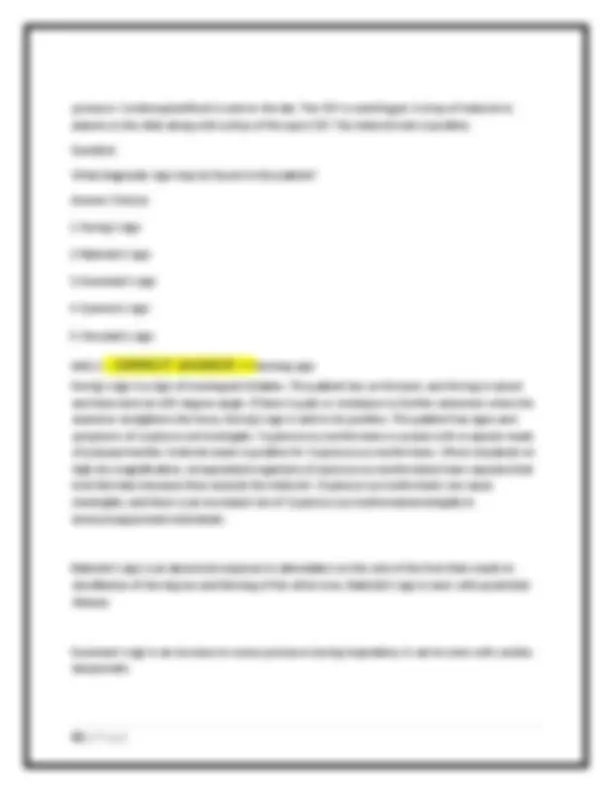
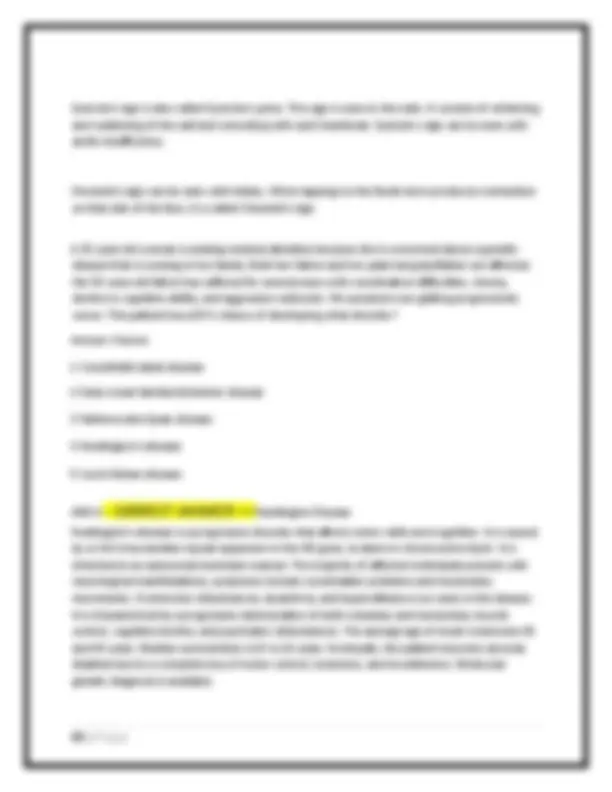
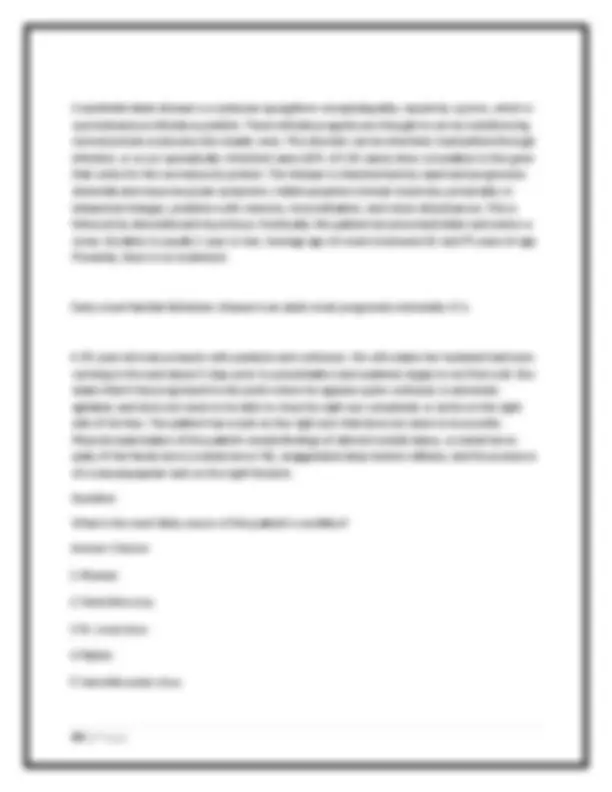
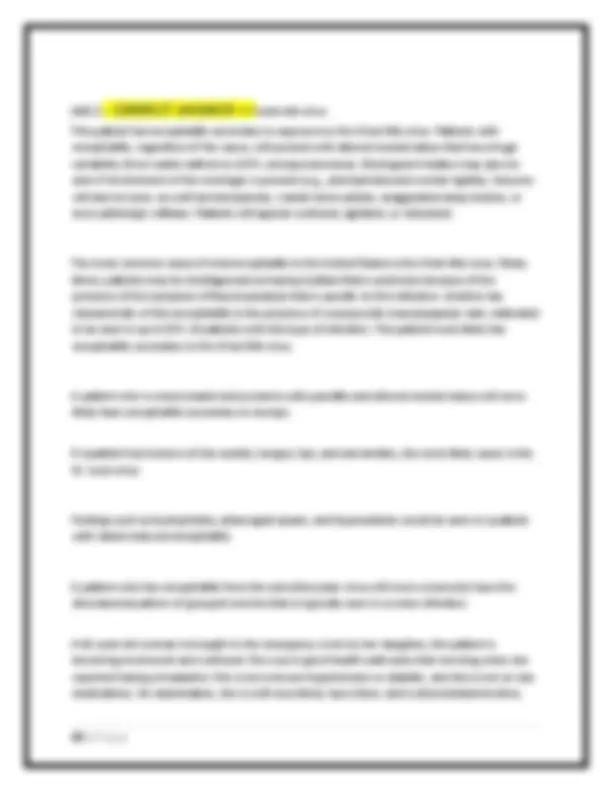
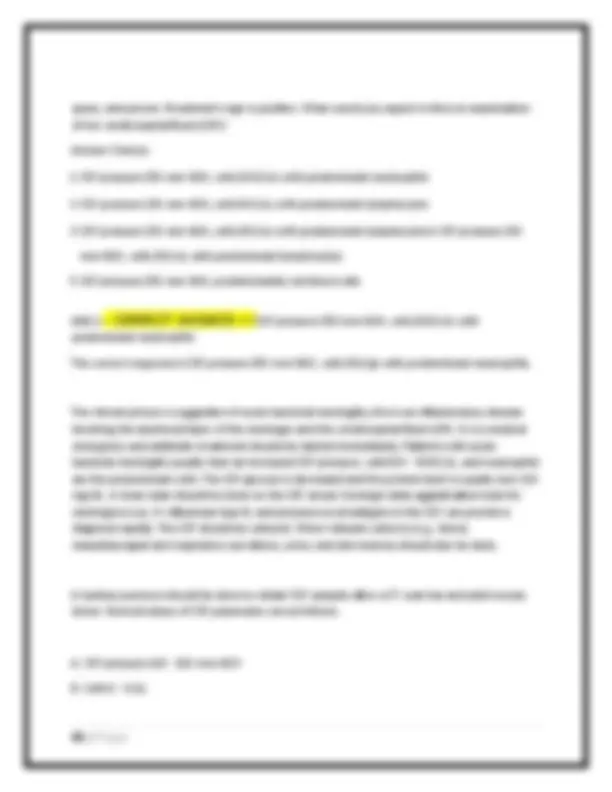
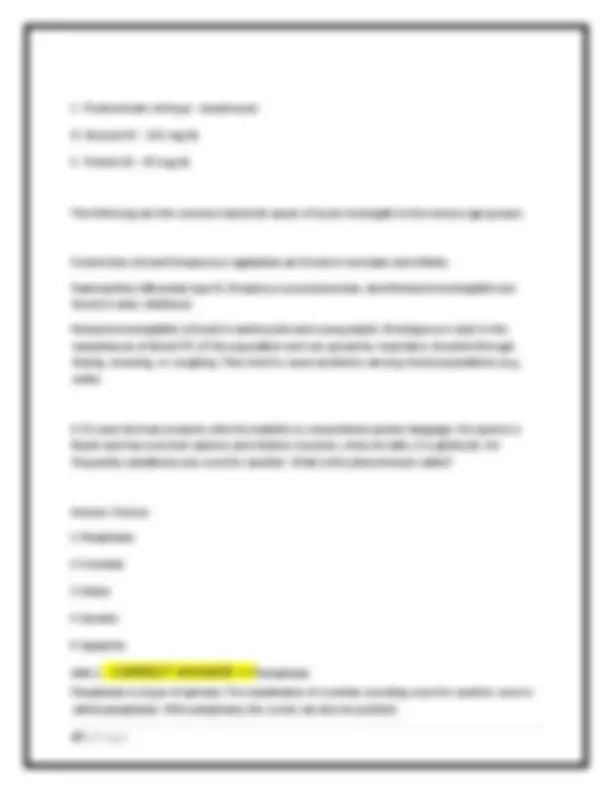
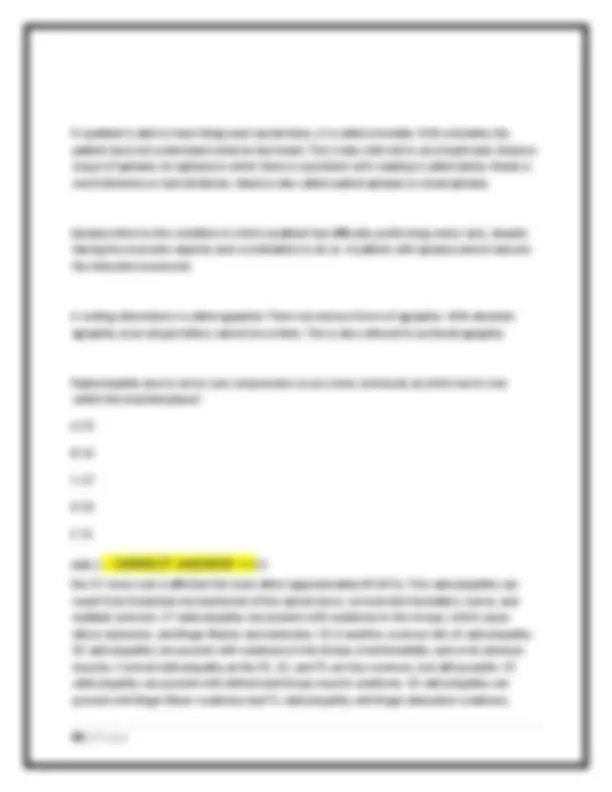
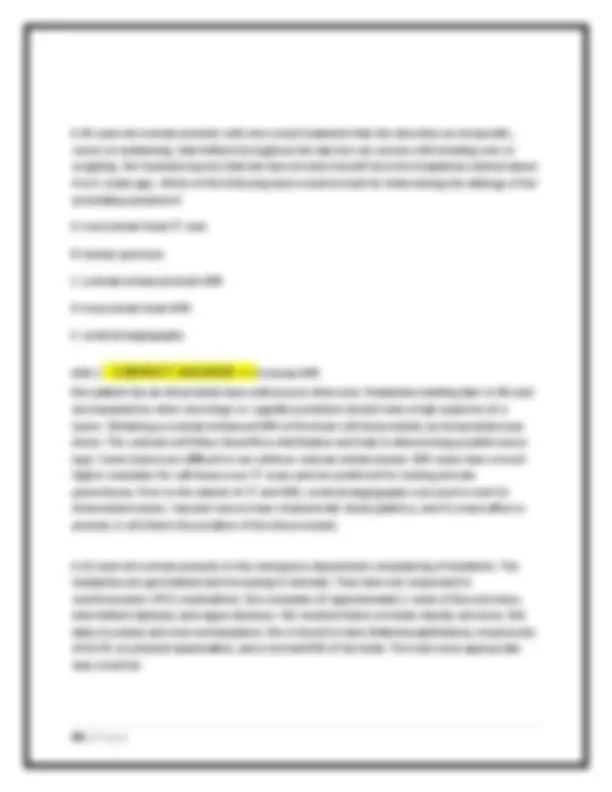
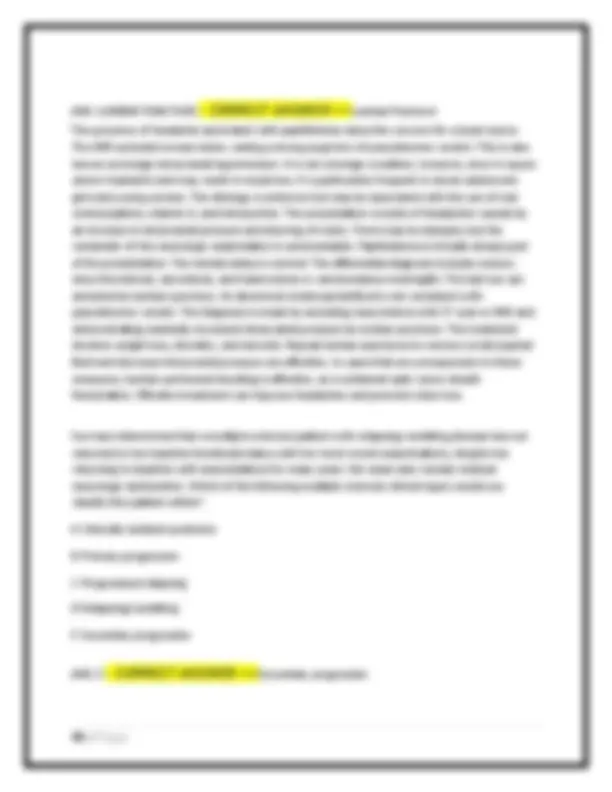
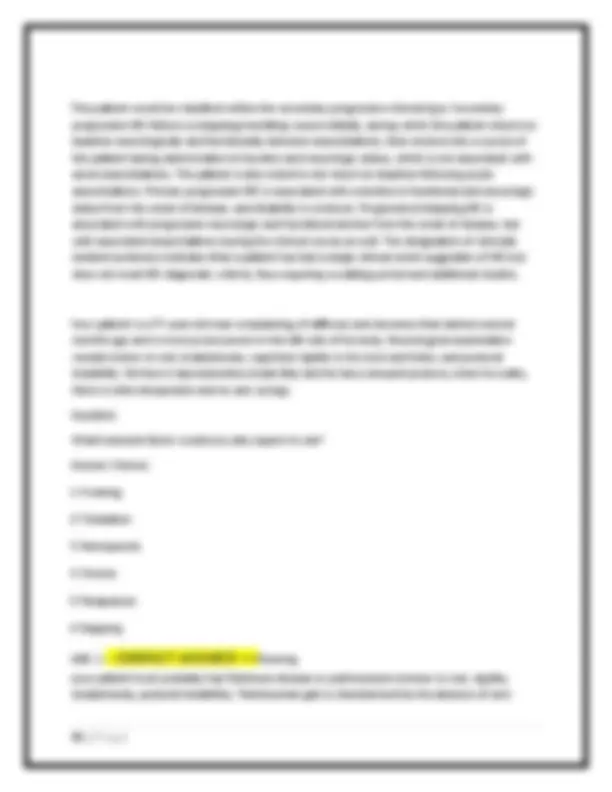
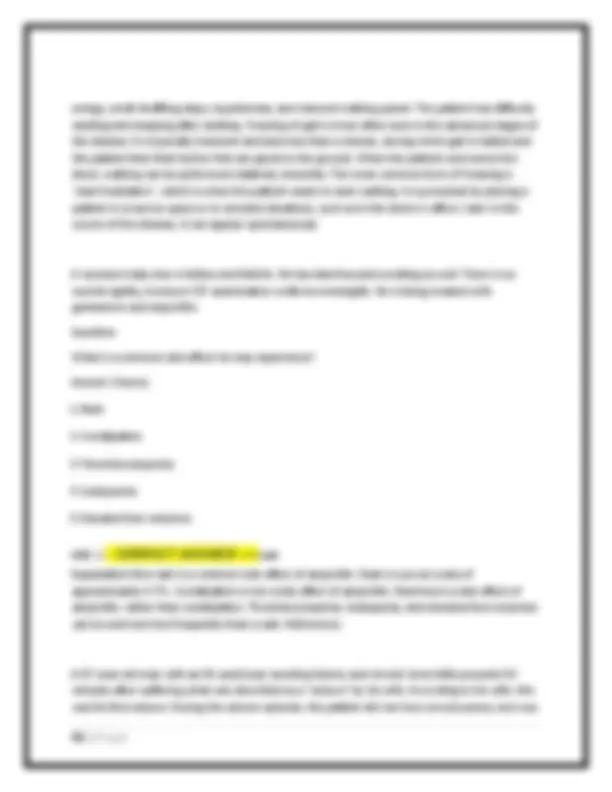
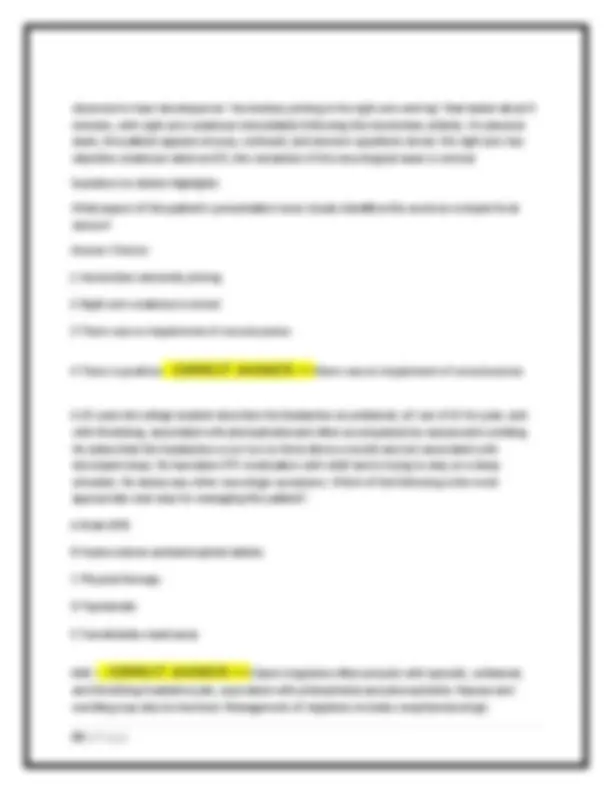
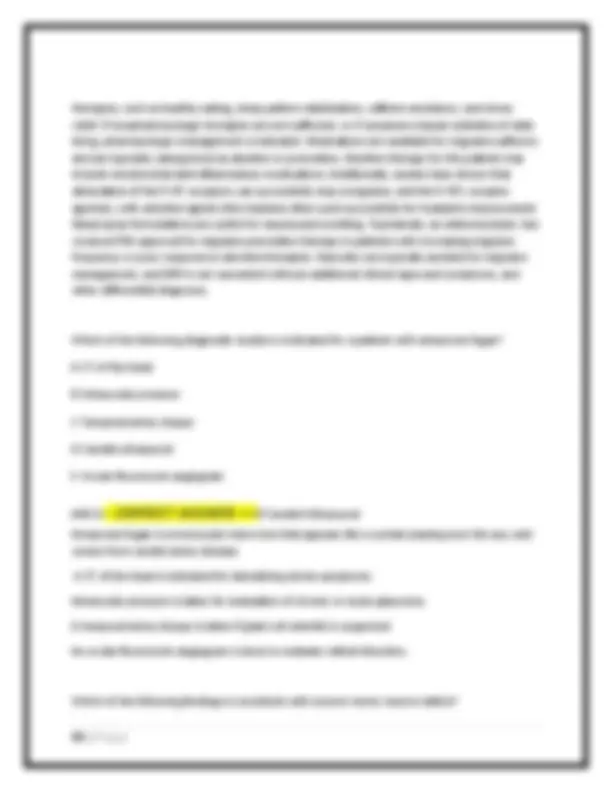
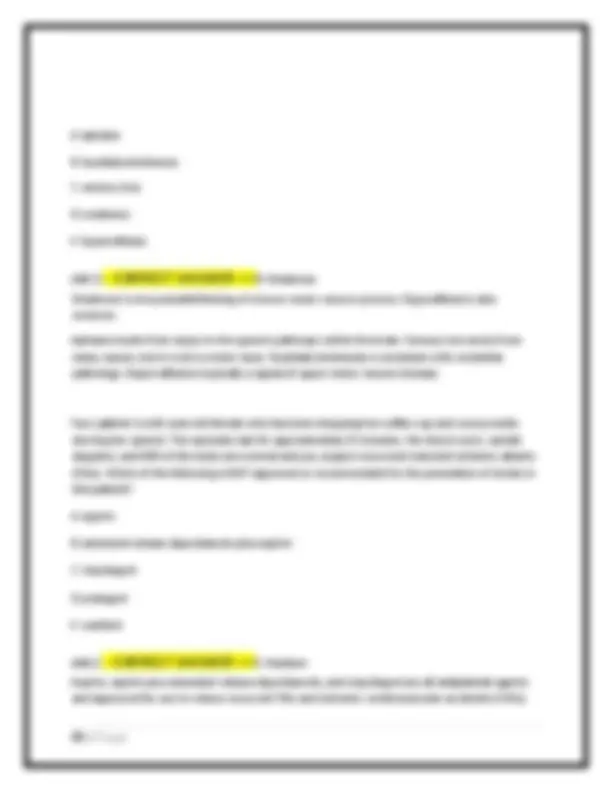
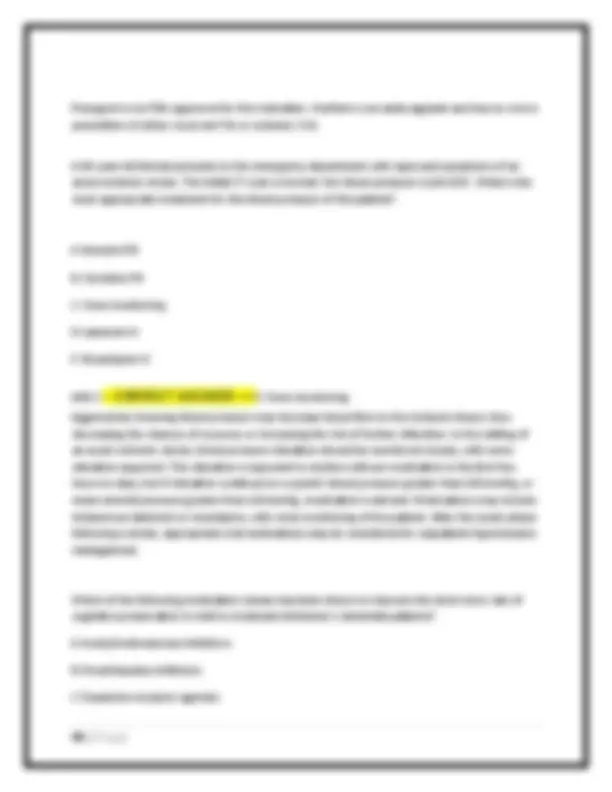
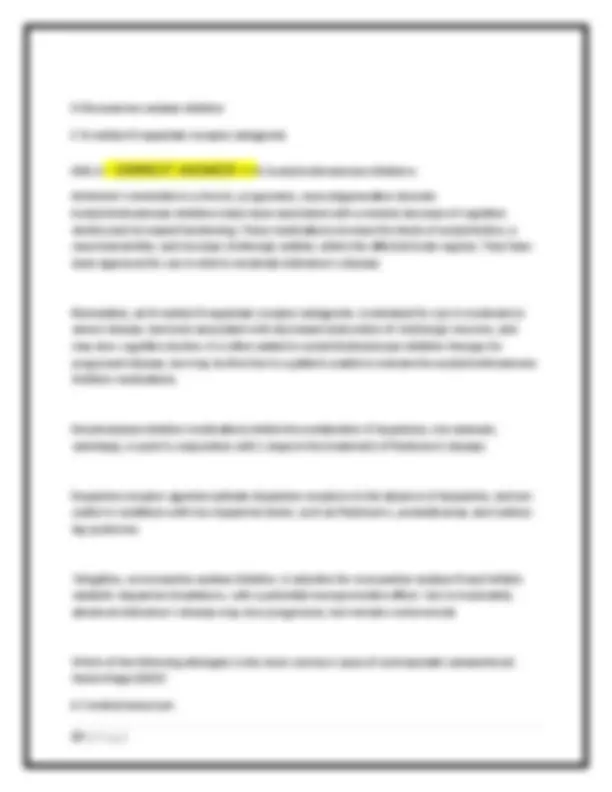
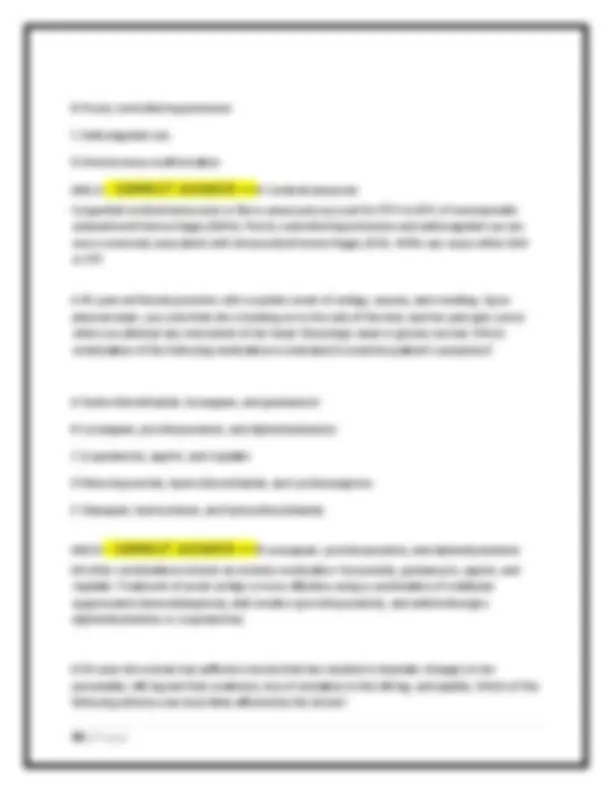
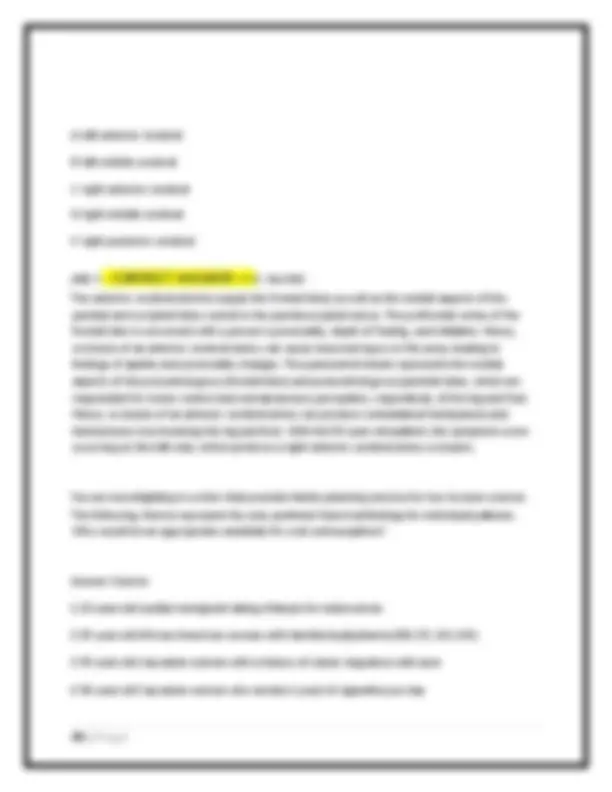
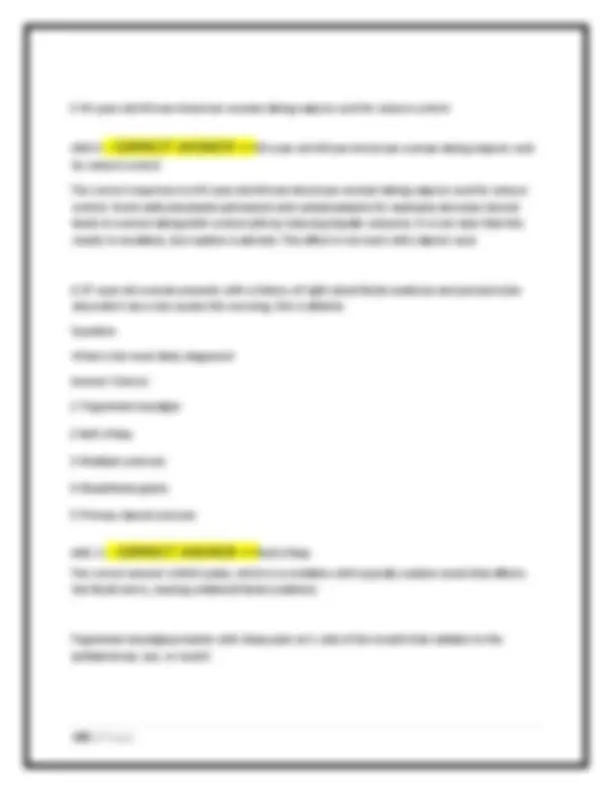


Study with the several resources on Docsity

Earn points by helping other students or get them with a premium plan


Prepare for your exams
Study with the several resources on Docsity

Earn points to download
Earn points by helping other students or get them with a premium plan
Community
Ask the community for help and clear up your study doubts
Discover the best universities in your country according to Docsity users
Free resources
Download our free guides on studying techniques, anxiety management strategies, and thesis advice from Docsity tutors
NR603 ACTUAL LATEST MIDTERM EXAM 2025 STRUCTURED QUESTIONS AND CORRECT REVISED ANSWERS ALREADY RATED 5 STARS AND AGRADED A 75-year-old man is involved in a motor vehicle accident and strikes his forehead on the windshield. He complains of neck pain and severe burning in his shoulders and arms. His physical examination reveals weakness of his upper extremities. What type of spinal cord injury does this patient have? A anterior cord syndrome B central cord syndrome C Brown-Séquard syndrome D complete cord transection E cauda equina syndrome ANS: B - CORRECT ANSWER >>>Central Cord Syndrome the central cord syndrome involves loss of motor function that is more severe in the upper extremities than in the lower extremities, and is more severe in the hands. There is typically hyperesthesia over the shoulders and arms.
Typology: Exams
1 / 178

This page cannot be seen from the preview
Don't miss anything!





























































































A 75-year-old man is involved in a motor vehicle accident and strikes his forehead on the windshield. He complains of neck pain and severe burning in his shoulders and arms. His physical examination reveals weakness of his upper extremities. What type of spinal cord injury does this patient have? A anterior cord syndrome B central cord syndrome C Brown-Séquard syndrome D complete cord transection E cauda equina syndrome
the central cord syndrome involves loss of motor function that is more severe in the upper extremities than in the lower extremities, and is more severe in the hands. There is typically hyperesthesia over the shoulders and arms. Anterior cord syndrome presents with paraplegia or quadriplegia, loss of lateral spinothalamic function with preservation of posterior column function. Brown-Séquard syndrome consists of weakness and loss of posterior column function on one side of the body distal to the lesion with contralateral loss of lateral spinothalamic function one to two levels below the lesion. Complete cord transection would affect motor and sensory function distal to the lesion. Cauda equina syndrome typically presents as low back pain with radiculopathy. A 37-year-old man fell from a ladder as he finished hanging the Christmas lights on his house. The right side of his head hit the alley cement, and he lost consciousness for about 1 minute; he woke up with a headache, but he had no other complaints. A few hours later, the patient is brought to the emergency room by his neighbor because of an intense headache, confusion,
and left hand hemiparesis. On examination, the patient has a bruise located over the right temporal region, mydriasis, and right deviation of the right eye, papilledema, and left extensor plantar response. An emergency CT scan of the head without contrast reveals a lens-shaped hyper-density under the right temporal bone with mass effect and edema. What is the most likely diagnosis? Answer Choices 1 Epidural hematoma 2 Subdural hematoma 3 Subarachnoid hemorrhage 4 Intracerebral parenchymal hemorrhage 5 Acute meningitis
Epidural hematoma most often results from a traumatic tear of the middle meningeal artery. Although a lucid interval ranging from minutes to hours followed by altered mental status and focal deficits is typical for epidural hematoma, this clinical picture is only encountered in up to 1/3 of the patients. The collection of blood between the skull and dura mater causes an evident mass effect with ophthalmic nerve palsy and the contralateral hemiparesis. Surgical evacuation of the clot via burr holes is the treatment of choice. Subdural hematoma results from a traumatic rupture of the bridging veins that connect the cerebrum to the venous sinuses within the dura. This venous hemorrhage will result in a gradual increase of the hematoma, with a progressive clinical picture over days or weeks. The CT scan will show a concave, crescent-shaped hyper-density compared to the convex, lensshaped hyper-density in epidural hematoma. Subarachnoid hemorrhage is the result of an aneurysm rupture; the most common is the congenital berry aneurysm. The clinical picture is of a sudden, severe headache with meningeal
Antibiotics are the treatment of choice for meningococcemia. The preferred drug for active infection is penicillin G. For those allergic to penicillin, chloramphenicol and cephalosporins (ie, cefotaxime, cefuroxime) may be used as alternatives. Patients will also receive supportive care, but antibiotic therapy must be initiated quickly if the patient is to survive. Intensive care placement may be necessary if organ failure is imminent. Ventilatory support, inotropic support, and IV fluids are necessary in some. If adrenal insufficiency occurs, corticosteroid replacement may be considered. A central venous line helps to provide large amounts of volume expanders and inotropic medications for adequate tissue perfusion. Steroids have not been shown to play a major role in the treatment of meningococcemia. However, they have been used in addition to antibiotic therapy. In the case of adrenal insufficiency, for example, steroid replacement has been shown to be beneficial. Transfusion does not generally play a major role in treatment. If the patient suffers from a devastating coagulopathy, blood or blood products may be replaced as necessary. Bactericidal/permeability-increasing protein is a protein stored in the granules of neutrophils. It binds to endotoxin in vitro and neutralizes it. This technique is experimental, and it is not used in everyday treatment of meningococcemia. In myasthenia gravis, weakness is a result of insufficient acetylcholine transmission at the neuromuscular junction; however, weakness can also occur with overdosing of the cholinergic medications used to treat myasthenia. What symptom helps differentiate a myasthenic crisis from a cholinergic crisis? Answer Choices 1 Respiratory failure
2 Bilateral ptosis 3 Muscle fasciculations 4 Diplopia 5 Normal muscle stretch reflexes
Signs of cholinergic overdosage include muscle fasciculation, rhinorrhea, lacrimation, salivation, increased bronchial secretions, nausea, or diarrhea. The presence of any of these suggests that the patient's weakness may be due to cholinergic crisis. The other signs are due to weakness and can occur in either condition. A 54-year-old man presents after having a generalized seizure. The patient is HIV positive, but he has been unable to afford antiretroviral therapy since losing his job 2 years ago. Other than cachexia, the physical exam is unremarkable. Upon further inquiry, the patient also notes that he has become short-tempered and hypercritical; at times, he seems confused. An MRI of the brain is performed, and it reveals several cortical ring-enhancing lesions. Question What is the most likely diagnosis? Answer Choices 1 AIDS dementia complex 2 Cryptococcal meningitis 3 Cytomegalovirus encephalitis 4 Progressive multifocal leukoencephalopathy 5 Toxoplasma encephalitis
The patient's symptoms and MRI findings are most consistent with the diagnosis of toxoplasma encephalitis. Toxoplasmosis is the most common cerebral mass lesion among HIV-positive
Awareness of self and the surrounding environment or consciousness may be altered into different abnormal states of consciousness. Consciousness can shift from loss of clear thinking or confusion, usually accompanied by disorientation, to delirium, a succession of confused and unconnected ideas manifested in children as extreme mental and motor excitement, to lethargy, a profound type of slumber where movement or speech is limited, to stupor or deep sleep where arousal is achieved only by repeated vigorous stimuli, finally to coma, unresponsiveness to even painful stimuli. Non-traumatic coma is most common in infants and toddlers with another smaller peak of occurrence in adolescence. The most common cause of non-traumatic altered level of consciousness in children is infection of either the brain (encephalitis), meninges (meningitis), or both; infections account for more than 1/3 of cases. Prolonged seizures, anticonvulsive therapy, and postictal states can also lead to altered levels of consciousness. The most common metabolic cause of alteration of consciousness is diabetic ketoacidosis, which can occur at any age, but is most common in adolescence. Caused by severe insulin deficiency, hyperglycemia and ketogenesis lead initially to polyuria, polydipsia, hyperpnea, vomiting, and abdominal pain. As the process progresses, hyperosmolar dehydration and acid/base and electrolyte disturbances occur. Advanced stages alter level of consciousness and can lead to coma. Alterations of consciousness due to inborn errors of metabolism that present with electrolyte and glucose abnormalities typically present in infancy. The availability of gluconeogenic precursors or the functions of the enzymes required for production of hepatic glucose are affected. Metabolic defects causing hypoglycemia include glycogen storage d A 44-year-old man starts to notice that his eyelids are drooping. Some time afterwards, his jaw becomes weak. He has difficulty swallowing and also experiences weakness in his limbs. He is quite embarrassed when he eats because he must use his hand to help support his jaw. His weakness gets progressively worse. Finally, he seeks medical attention. His physical examination demonstrates the weakness in his limbs; however, no sensory defects are present. A Tensilon
test is done and is positive. His doctor is concerned about an associated malignancy. What is the underlying pathology of this disease? Answer Choices 1 Inhibition of acetylcholine release 2 Blockage of the sodium channels 3 Demyelination 4 Subacute combined degeneration of the spinal cord 5 Antibodies to the acetylcholine receptor
Antibodies directed towards the acetylcholine receptor at the neuromuscular junction are seen with myasthenia gravis. This man has myasthenia gravis. Ocular muscle weakness, ptosis, dysphagia, and limb weakness can all be seen with myasthenia gravis. When the initial symptom is ocular weakness, Eaton Lambert Syndrome is extremely unlikely. Eaton Lambert Syndrome tends to not involve the extra-ocular muscles or the muscles involving chewing, swallowing, or speech. The Tensilon test is used in the diagnosis of myasthenia gravis. The Tensilon test consists of the administration of edrophonium. Edrophonium is a quick acting anticholinesterase. Thymic tumors are associated with myasthenia gravis. Thymic tumors are also referred to as thymomas. Approximately 10 - 15% of patients with myasthenia gravis have an associated thymoma. The majority of patients with myasthenia gravis have hyperplasia of their thymus.
Nimodipine, a calcium channel blocker, has been shown to improve outcomes in patients following aneurysmal SAH. The mechanism of action is thought to be prevention of ischemia. Glucocorticoids (e.g., prednisone) are often utilized in patients with SAH because they offer symptomatic relief of headache and neck pain, but they have not been proved to decrease cerebral edema. Antifibrinolytic agents (e.g., Tranexamic acid) can be utilized in patients with a diagnosed aneurysm who cannot undergo directed treatment, but they are not routinely used following aneurysmal rupture. Labetalol (a beta blocker) may be utilized to treat elevated BP, but it must be used with caution because it can also decrease cerebral perfusion. Diuretics (e.g., furosemide) have no identified role in the treatment of aneurysmal SAH.
Explanation The correct answer is Bell's palsy, which is a condition typically with sudden onset that affects the facial nerve, causing unilateral facial weakness. Trigeminal neuralgia presents with sharp pain on one side of the mouth that radiates to the ipsilateral ear, eye, or nostril. Multiple sclerosis is a demyelinating disorder, causing a multitude of symptoms that typically include diplopia or blurred vision early on, then an insidious onset of progressive weakness, numbness, and/or tingling in the extremities. Myasthenia gravis commonly presents with ptosis and diplopia, as well as difficulty swallowing, fatigue, and muscle weakness.
Decreased CSF glucose and increased polymorphonuclear cell counts are seen in acute bacterial meningitis. Decreased CSF glucose and elevated CSF lymphocyte counts are commonly seen with meningitis caused by fungi. Viral meningitides usually presents with elevated lymphocyte counts, normal CSF glucose, and normal or slightly elevated CSF protein levels. A 70-year-old woman is brought to your attention by her family because of the slowly progressive gait disorder, the impairment of mental function, and urinary incontinence. About 1 year ago, she started having weakness and tiredness in her legs, followed by unsteadiness; her steps became shorter and shorter, and she also experienced unexplained backward falls. She is becoming emotionally indifferent, inattentive, and her actions and thinking have became "dull". Over the past month, she has started having urinary urgency and involuntary leaking of urine. Besides multivitamins and local application of the Timolol for glaucoma, she takes no other medications; there are no other symptoms. Question What is most likely the best method of treating the patient's urinary problems? Answer Choices 1 Antimuscarinic drug (Tolterodine) 2 Antibiotic (Sulfamethoxazole/trimethoprim) 3 Acetylcholinesterase inhibitor (Donepezil)
Clinical triad of slowly progressive gait disorder, followed by impairment of mental function and then sphincteric incontinence strongly suggests the presence of normal-pressure hydrocephalus. Ventricular expansion is the cause of symptoms, and surgical CSF shunting is the main treatment modality. The potential benefit from surgery is usually evaluated by testing gait, cognition, and micturition before and after CSF drainage.
3 MRI of the head
The infant in the vignette appears to have bacterial meningitis. The initial approach to the patient should be the "ABCs." After assessing and stabilizing the patient's airway and obtaining IV access, intravenous antibiotics should be given immediately. As bacterial meningitis is associated with high morbidity and mortality, prompt initiation of empirical antibiotics is crucial for better prognosis. The choice of antibiotics is dependent on the patient's age and specific predisposing conditions. Use of broad-spectrum cephalosporins, such as ceftriaxone or cefotaxime with vancomycin, may be used in infants more than 1 month old. Ideally, serum glucose, blood culture, complete blood count, and serum chemistries should be drawn when IV access is obtained; however, drawing labs should not delay beginning antibiotics. Intravenous glucose is necessary if the patient is found to be hypoglycemic; bedside serum glucose is mandatory in any patient that presents with a seizure. Intravenous phenytoin and an MRI of the head might also be necessary for a patient such as the one in the vignette, but would not emergently precede antibiotics. The diagnosis of bacterial meningitis rests on CSF examination performed after lumbar puncture. However, LP is deferred in patients with evidence of increased intracranial pressure, new onset seizure, cardiorespiratory compromise, or focal neurological deficits. Antibiotics should be given, and CT scan of the head should be performed. If CT scan is negative, LP can be performed. A 12-year-old girl presents with a 3-day history of progressive dysarthria, dysphagia, and weakness. The patient was well until 3 days prior to admission to the hospital; at that time, she developed the onset and subsequent gradual worsening of dysarthria. She attributed the dysarthria to a sore throat that she had had about 2 weeks earlier. 3 days prior to admission, she also had the onset of mild dysphagia; it mostly occurred with liquids. 24 hours prior to admission, she developed weakness in both upper extremities, which increased and began to involve the lower extremities. This limb weakness was neither worsened by activity nor improved by rest. She also developed tingling in her toes 24 hours prior to presentation. When
she became unable to walk without assistance on the day of admission, she decided to seek medical attention and was admitted to the hospital.
evolving clinical course indicates a poor prognosis This patient must be watched very closely for the very real possibility of respiratory failure and the need for ventilatory support (2). Mortality is expected to be less than 5% with good medical support (1). With a demyelinating pattern on EMG, her prognosis is better. A consistent indicator of residual muscle weakness is an EMG pattern of axonal damage, with the more severe degrees of damage suggesting the worse prognosis (1). About 85% of patients with GBS have a full functional recovery within a year; however, some may be left with minor residuals such as areflexia on exam (2). Between 5-10% of patients with Guillain-Barre have 1 or more relapses; these cases are referred to as chronic inflammatory demyelinating peripheral neuropathy (CIDP) (1). A 45-year-old African-American man with no significant past medical history presents with a 1hour history of left retroorbital headache. The headache was of a sudden onset and began upon waking that morning. It is described as excruciating, stabbing, sharp, and lancinating; it is rated as severe in intensity. He denies any preceding infections, nausea, vomiting, photophobia, or osmophobia; he also denies fever, chills, stiff neck, focal weakness, numbness, tingling, vision, hearing, gait, or speech changes. He recalls a similar episode several months ago; it lasted about a week, and it dissipated without complications. His physical exam is remarkable for painful distress, lacrimation with conjunctival injection, nasal congestion, rhinorrhea, left ocular miosis, and left forehead diaphoretic flushing.
Anticonvulsants such as Divalproex and Topiramate are preventative medications whose mechanism of action may involve regulation of central sensitization. Prednisone is very effective for abo A 48-year-old woman presents after a seizure. Prior to the seizure, she experienced confusion and disorientation preceded by nausea, vomiting, and blurred vision. Symptoms appeared after working for several hours in the garden under the sun. Her medical history is significant for the presence of schizophrenia, for which she takes chlorpromazine at bedtime. Her temperature is 41 C; BUN and creatinine are elevated; and there is neutrophilia, hemoconcentration, and lactic acidosis. You think that the event is possibly drug-related. Question What is the most likely diagnosis? Answer Choices 1 Heat cramps 2 Neuroleptic malignant syndrome 3 Heat stroke 4 Malignant hyperthermia 5 Heat exhaustion
Heat disorders can be exertional and nonexertional. Both can be drug-related. Neuroleptics (e.g., phenothiazines, thioxanthenes) may impair thermoregulation due to both anticholinergic and antidopaminergics effects. Anticholinergics inhibit sweating, therefore disturbing thermoregulation during exercise or under conditions of environmental heat stress. Antidopaminergics elevate the set point of the temperature regulation center in hypothalamus. Your patient most probably suffered heat stroke. It is a life-threatening condition characterized by elevated body temperature with nausea, blurred vision, confusion, disorientation, and
seizures. Hemoconcentration, anuria, rhabdomyolysis, kidney dysfunction, lactic acidosis, and even disseminated intravascular coagulation may result. Heat cramps are a mild disorder characterized by painful muscle contractions due to temporary fluids and electrolytes depletion. There are no signs and symptoms of neurological dysfunction, and body temperature is normal. Neuroleptic malignant syndrome is an idiosyncratic reaction to neuroleptics, most commonly phenothiazines and butyrophenones, and it is characterized by rigidity, fever, and autonomic instability. It is not connected with the exposure to heat and exertion. Men under 40 are at greatest risk. Malignant hyperthermia is a nonexertional idiosyncratic reaction to the anesthetic. Heat exhaustion is a condition with a severity that lies between heat cramps and heat stroke. Body temperature might be slightly elevated, and there may be neurological signs like headache, but there will be neither severe confusion nor seizures. A 17-year-old adolescent male presents with unexplained neurological symptoms. His liver is enlarged on palpation, and he has other symptoms of hepatitis. Blood work reveals depressed ceruloplasmin levels. An ophthalmological examination reveals Kayser-Fleischer rings. What is the most likely diagnosis? Answer Choices 1 Krabbe disease 2 Lesch-Nyan syndrome 3 Marfan syndrome 4 Wilson disease 5 Hunter syndrome